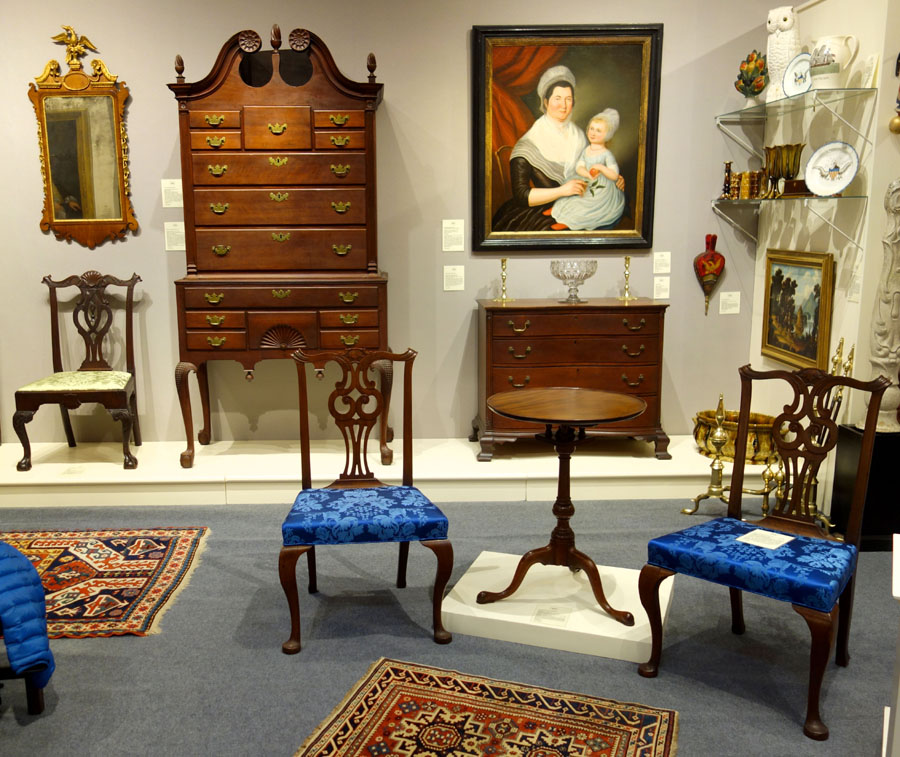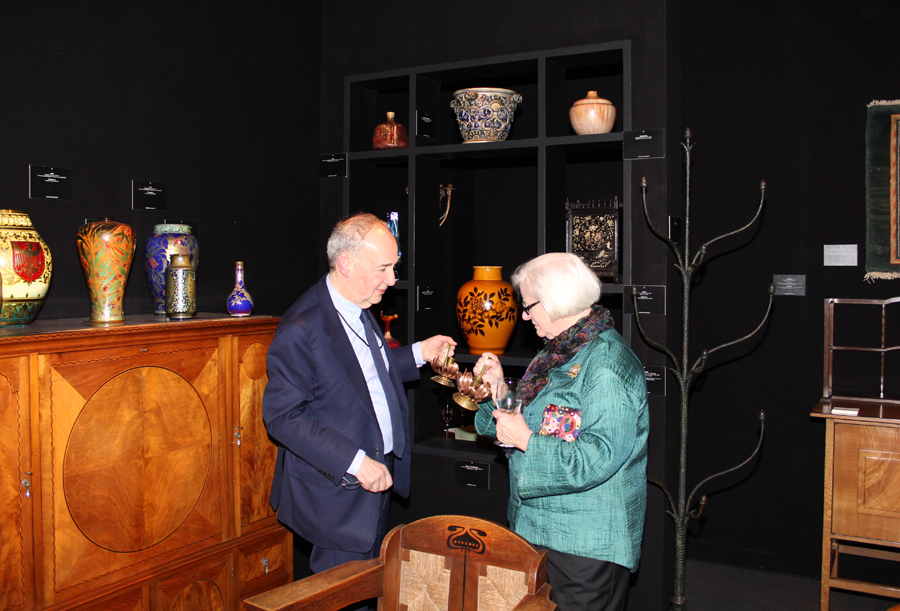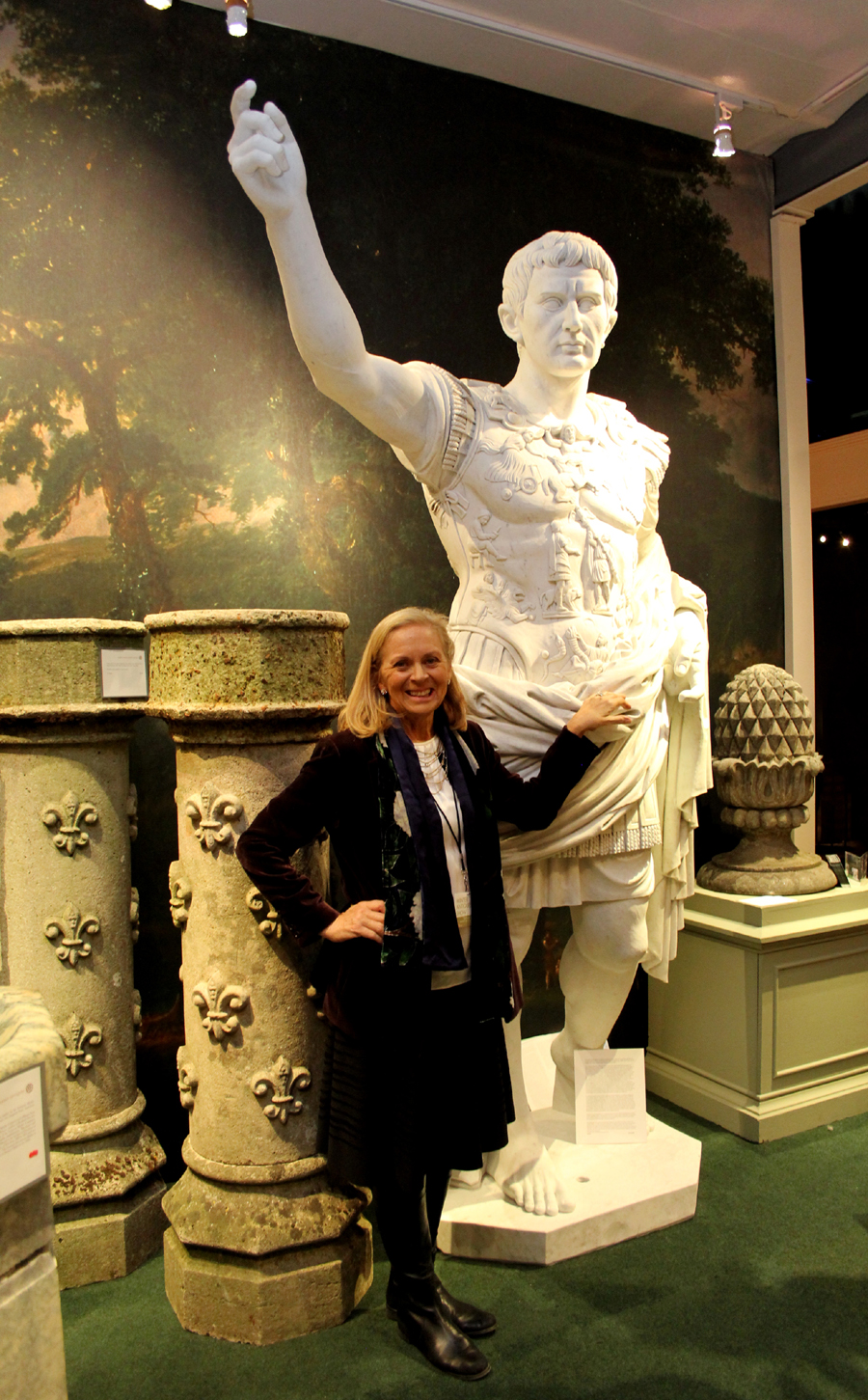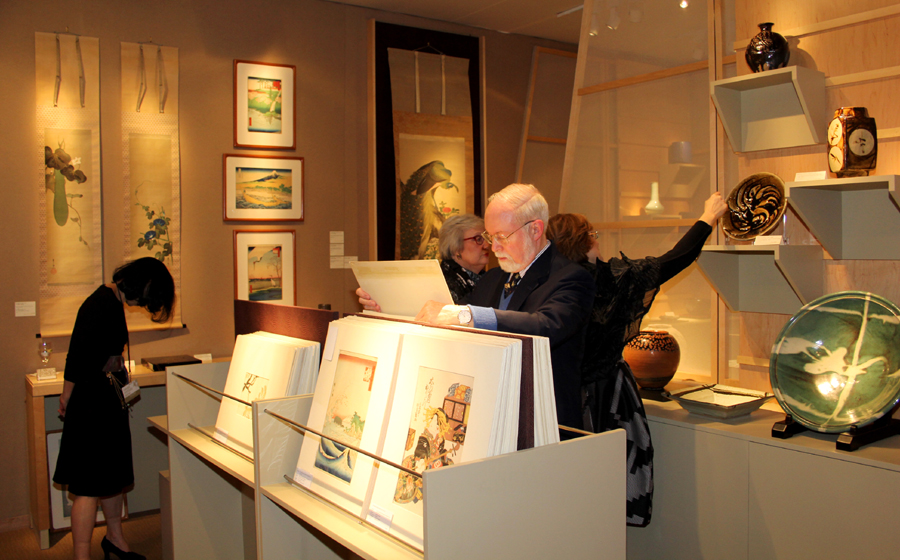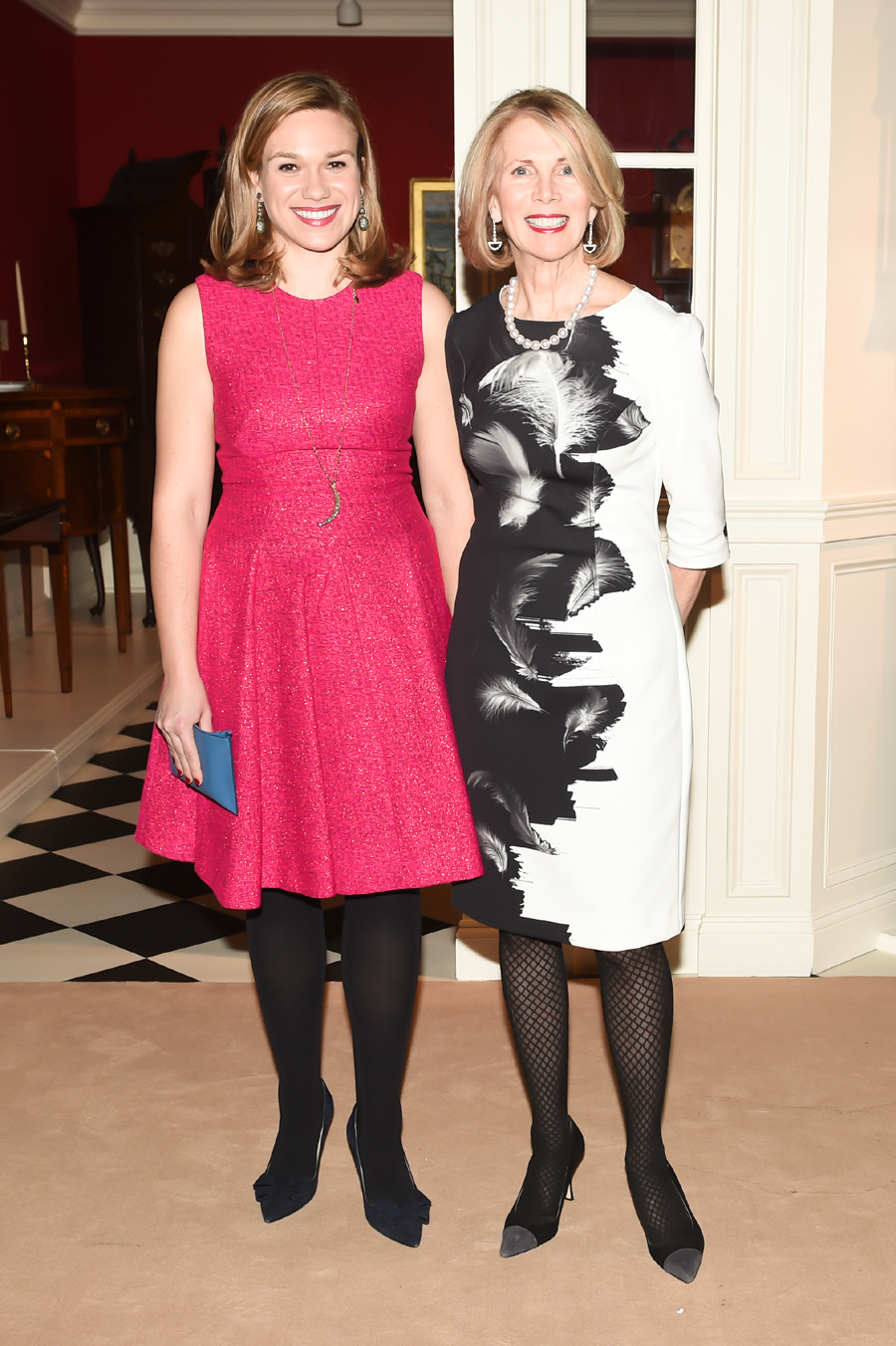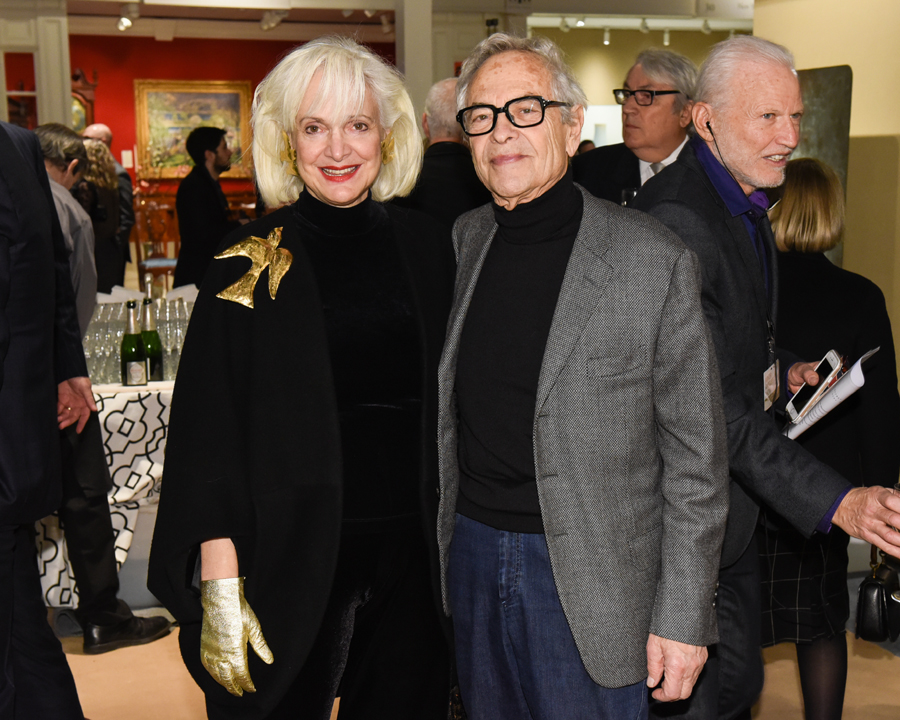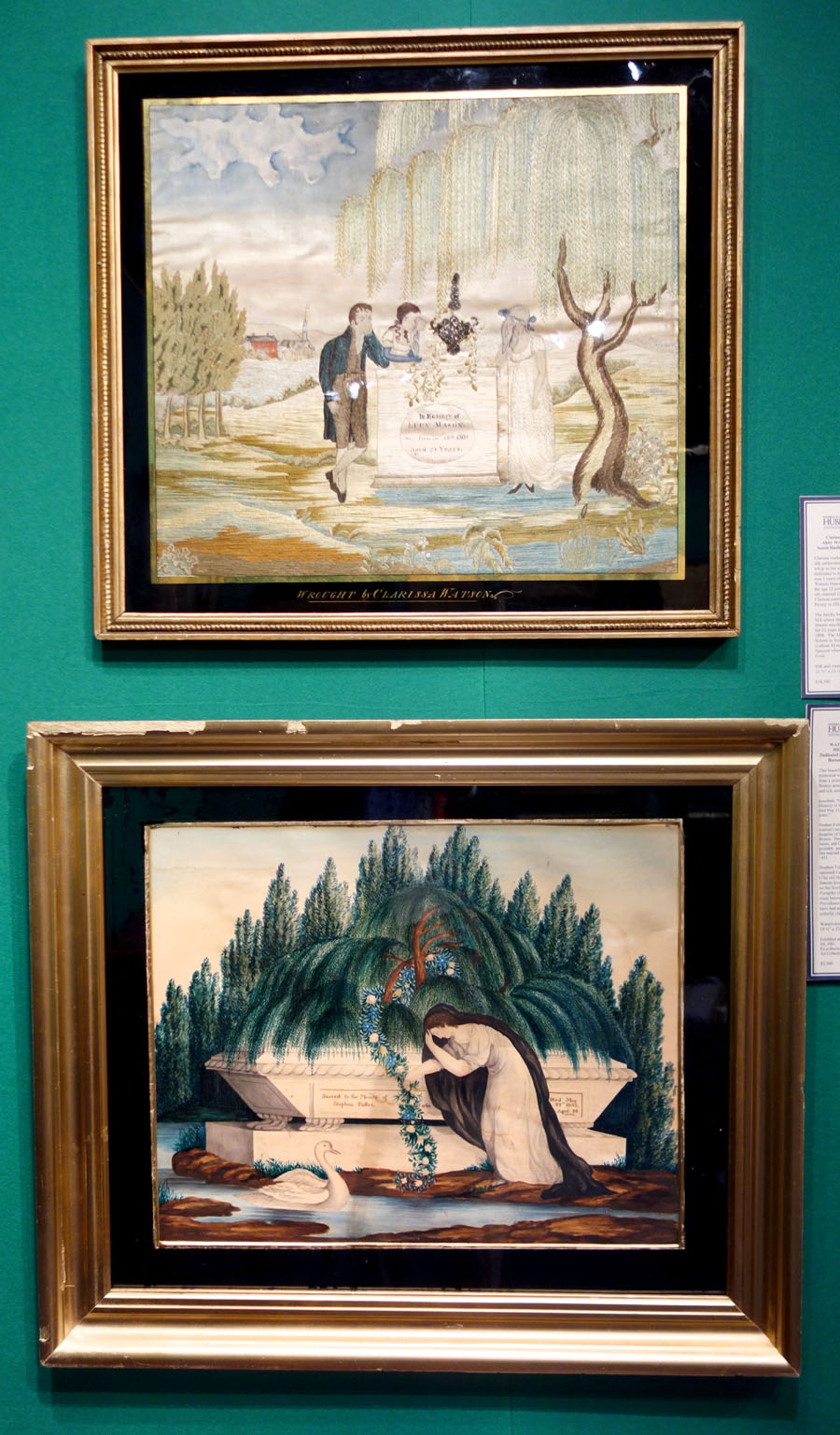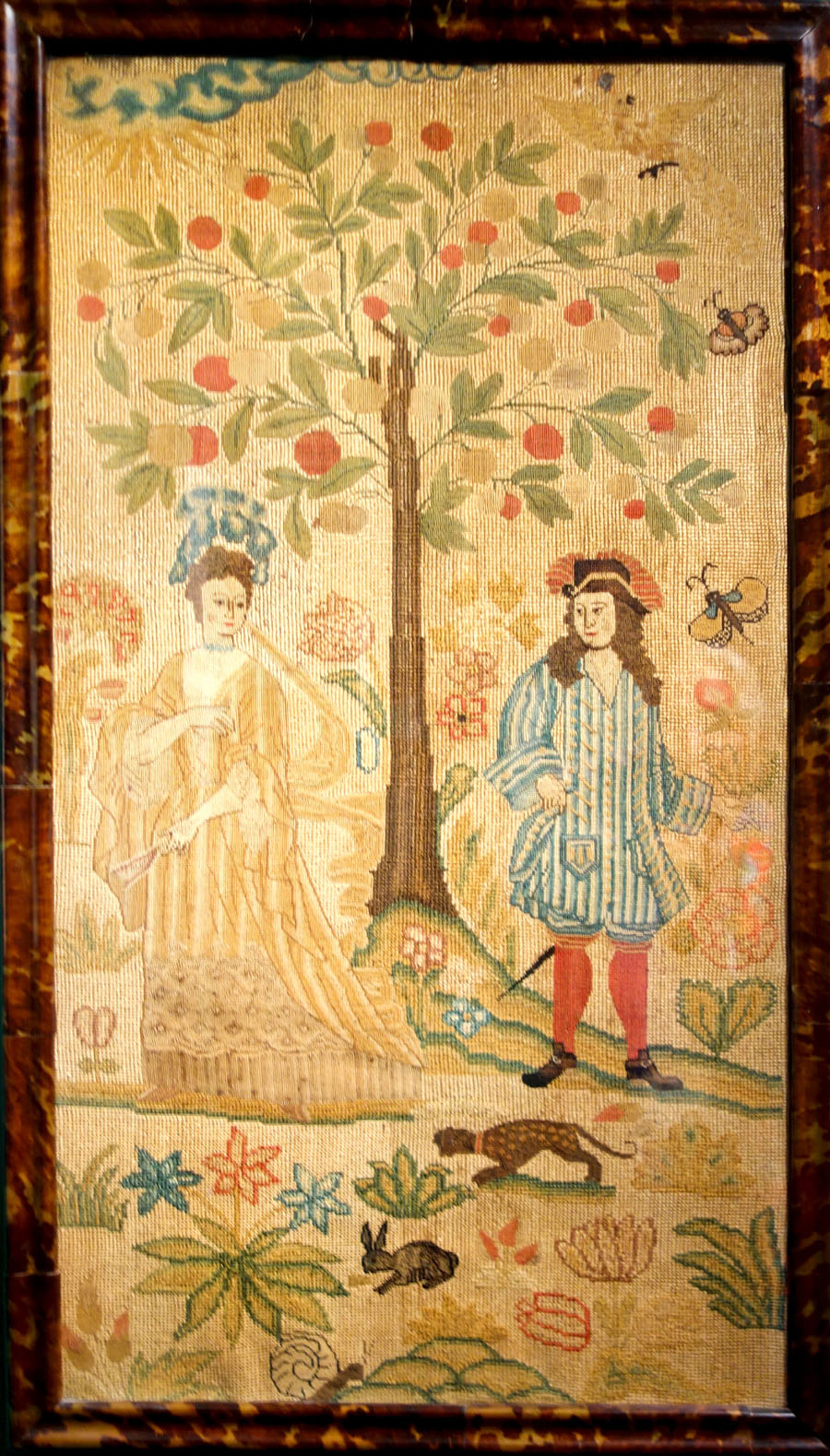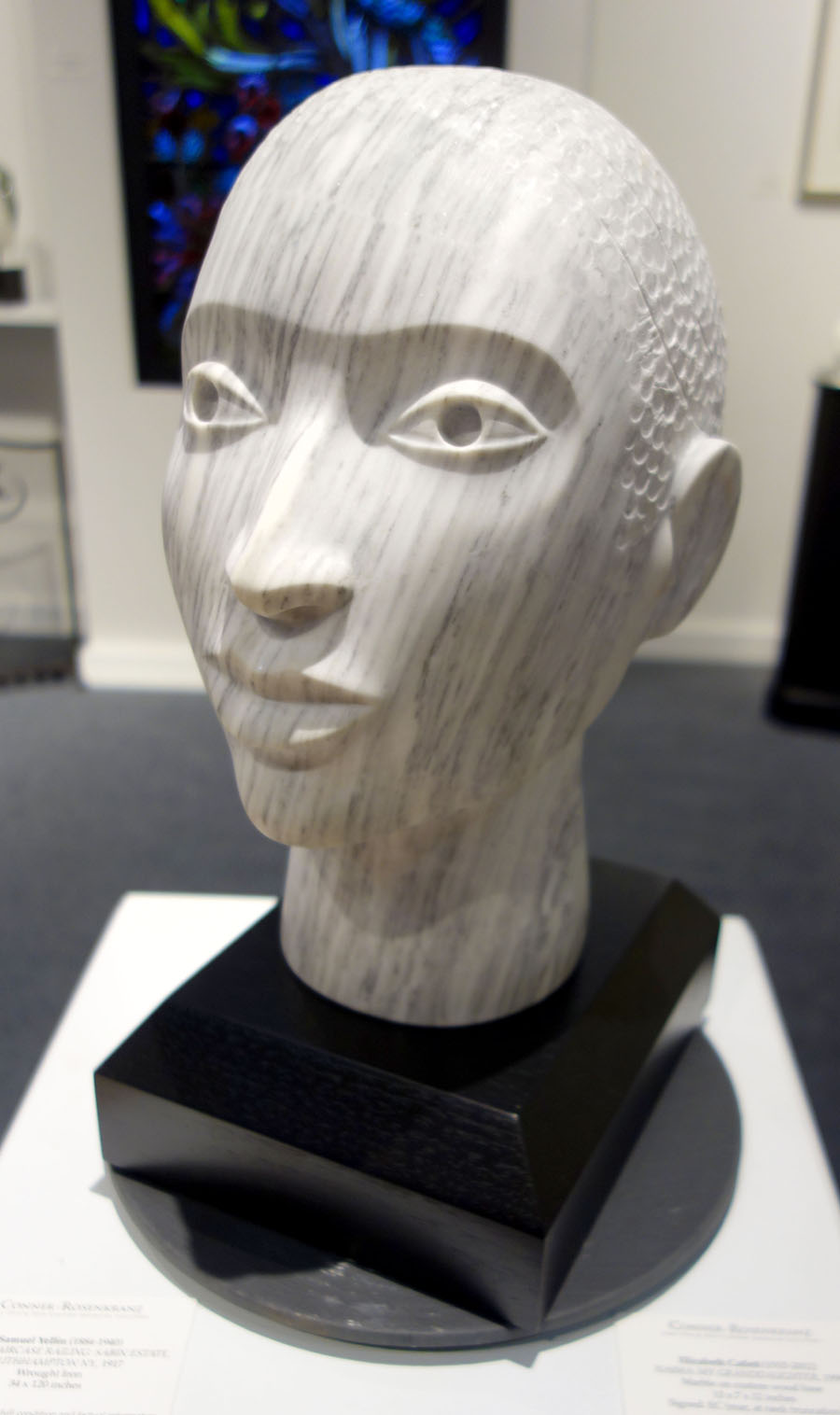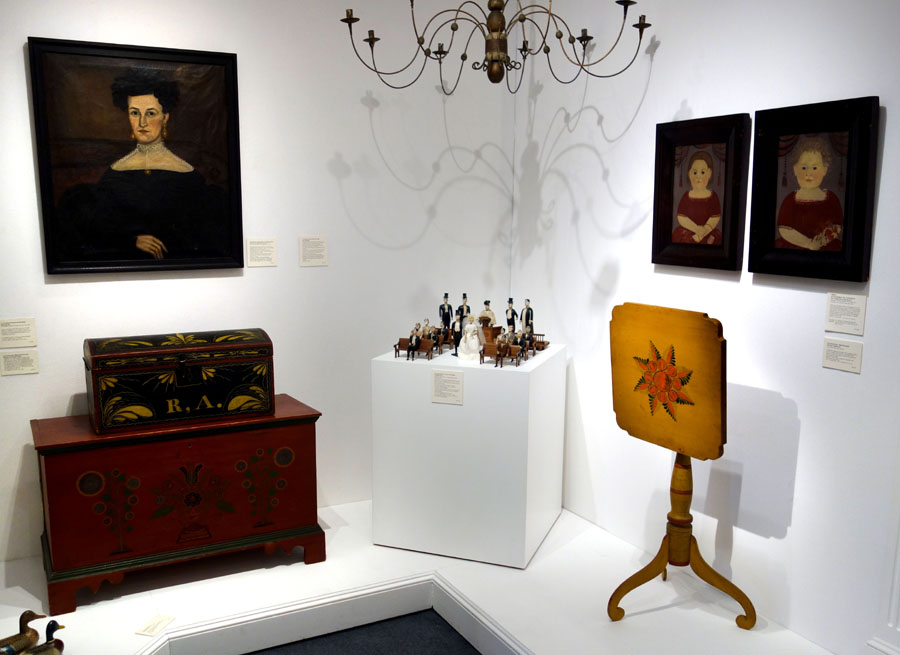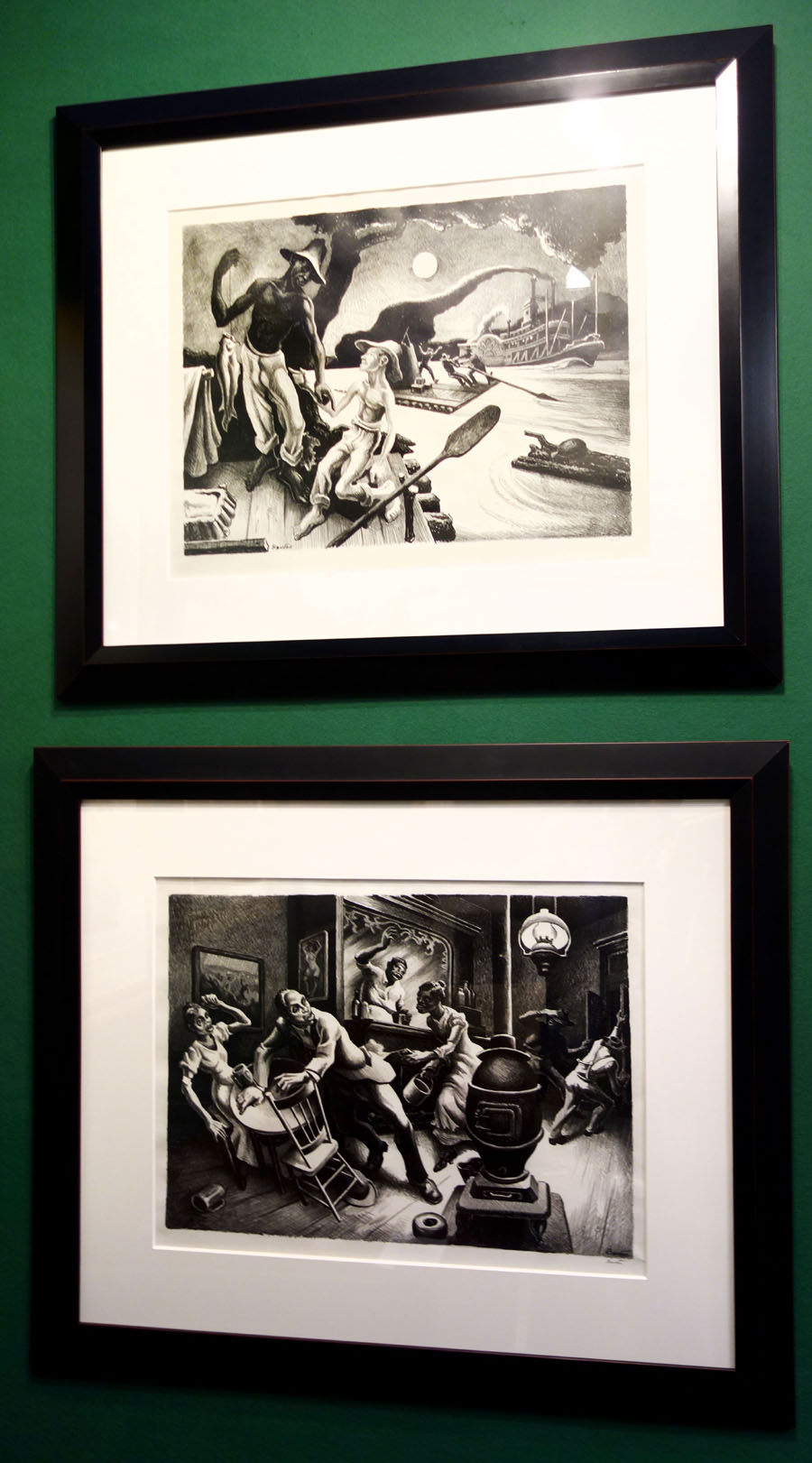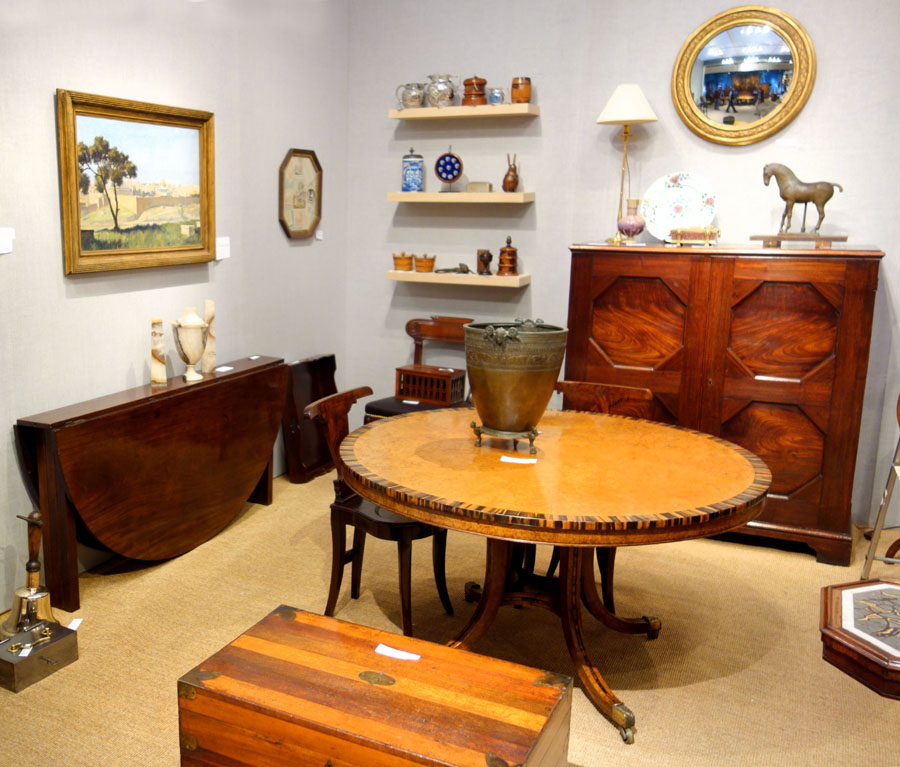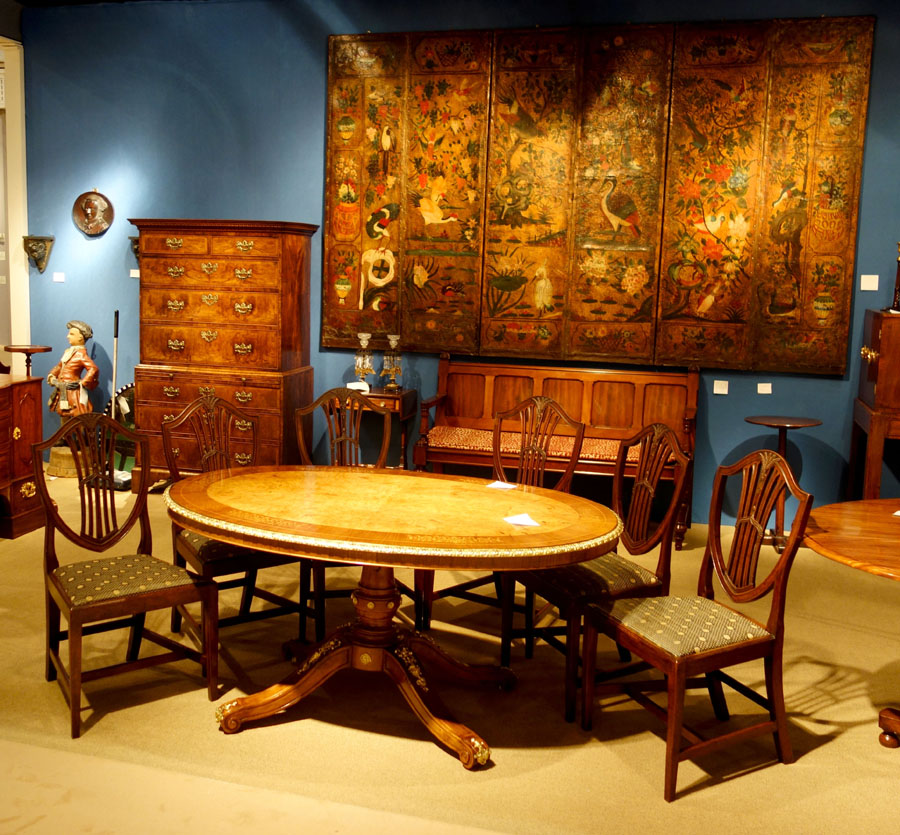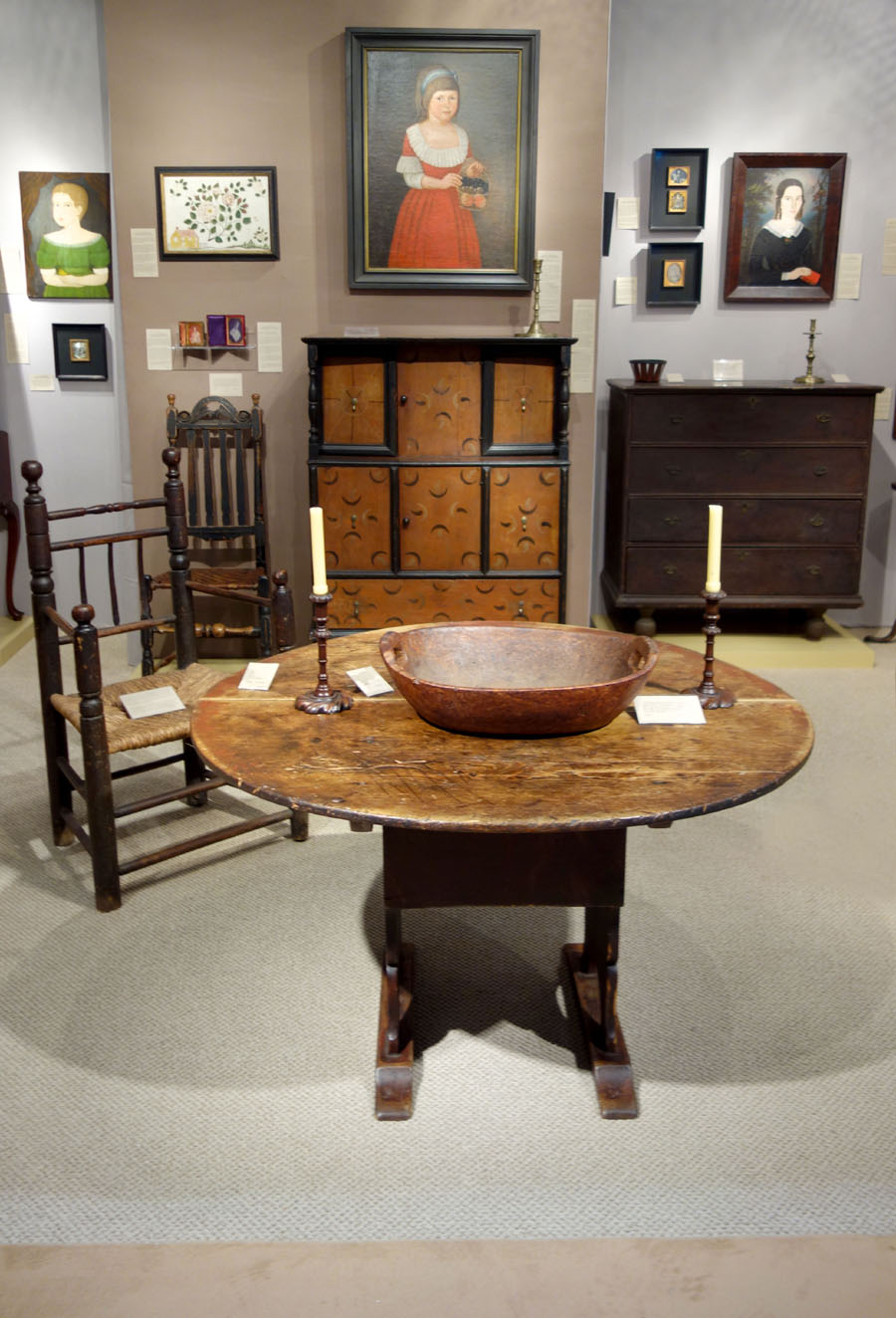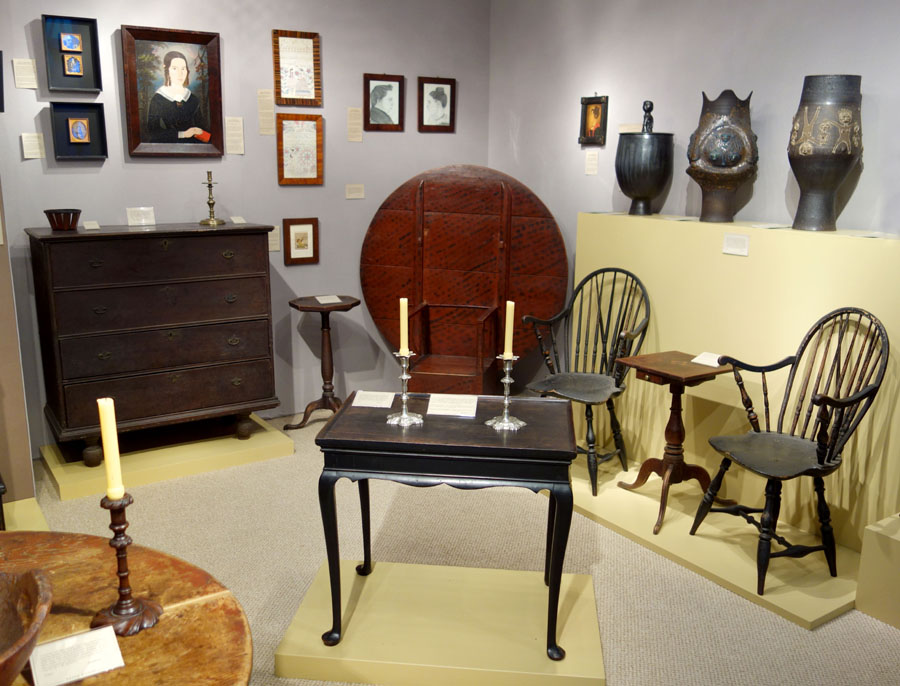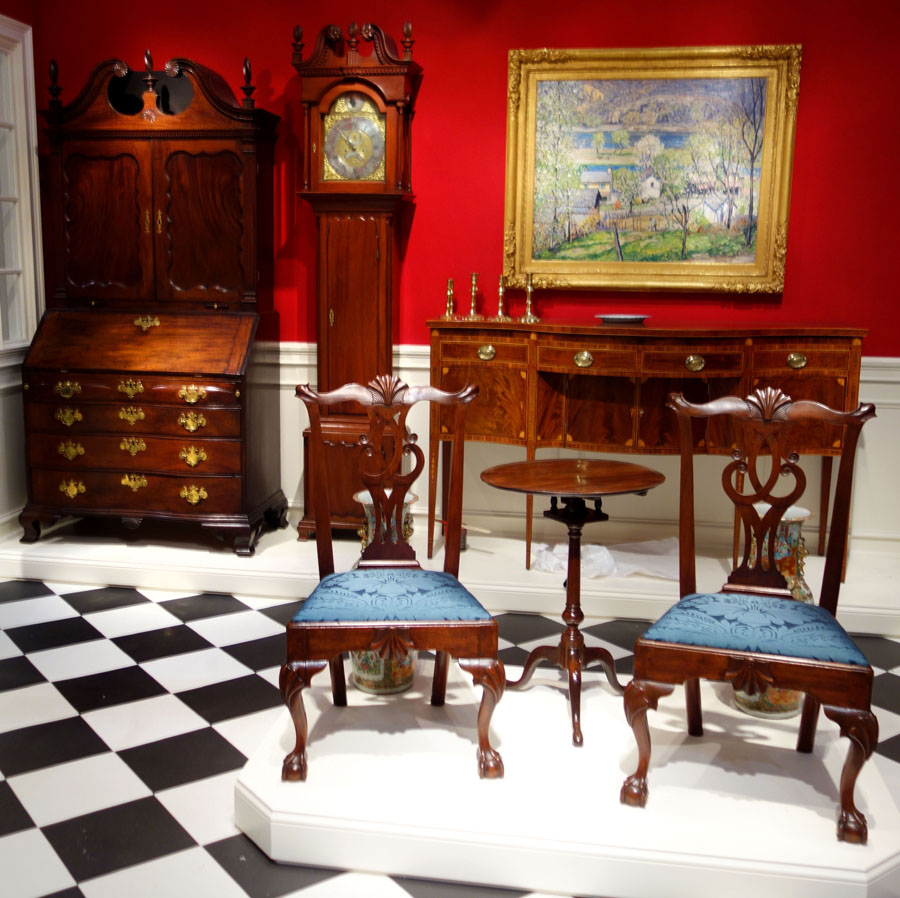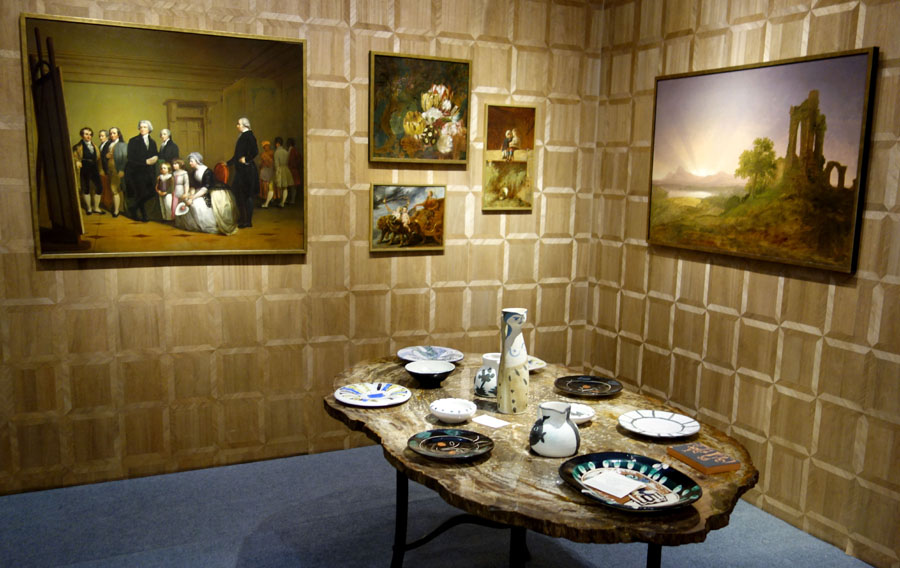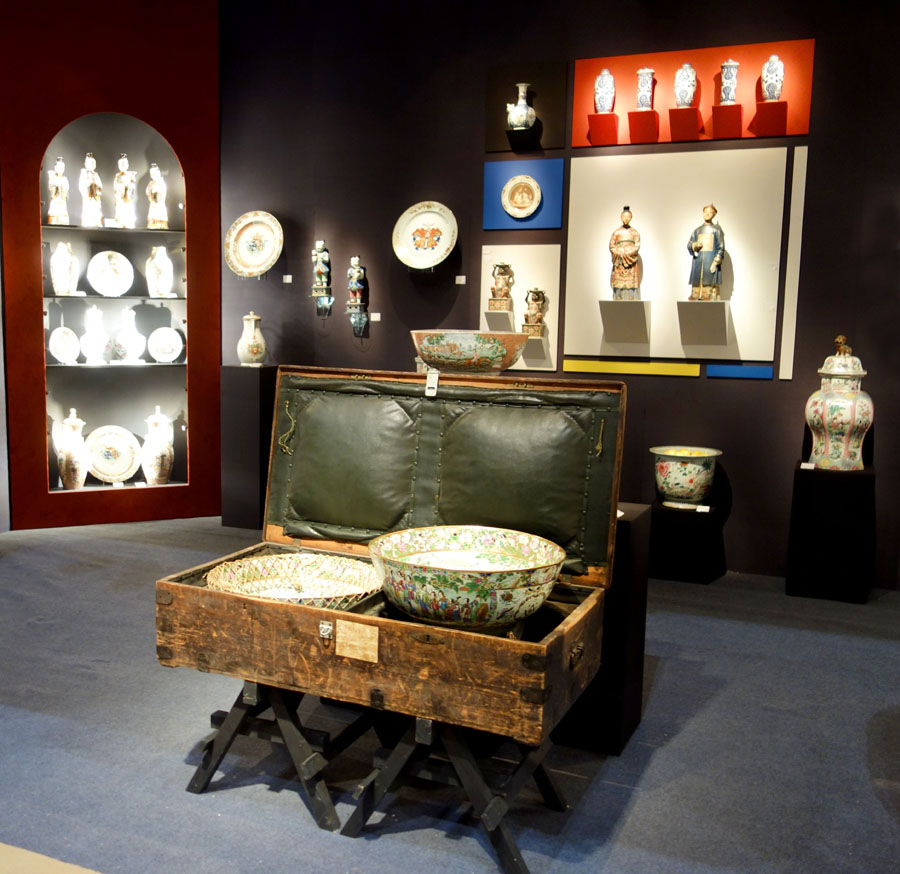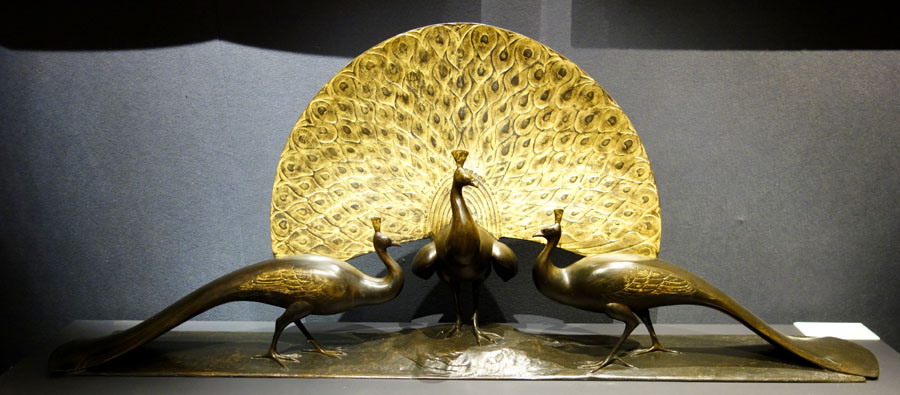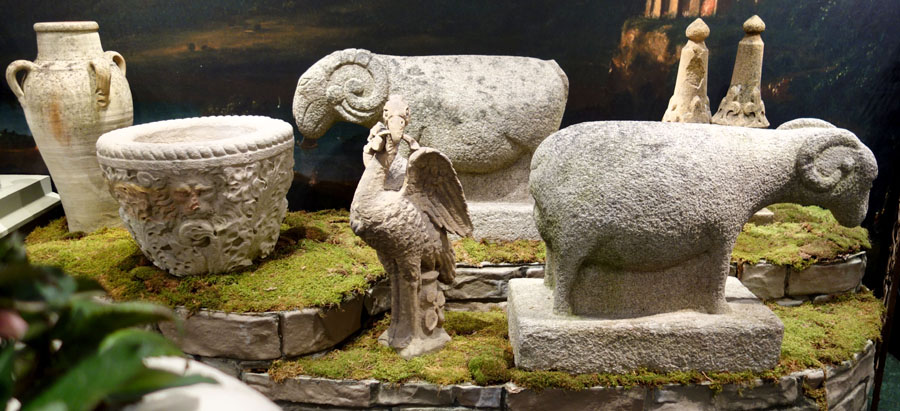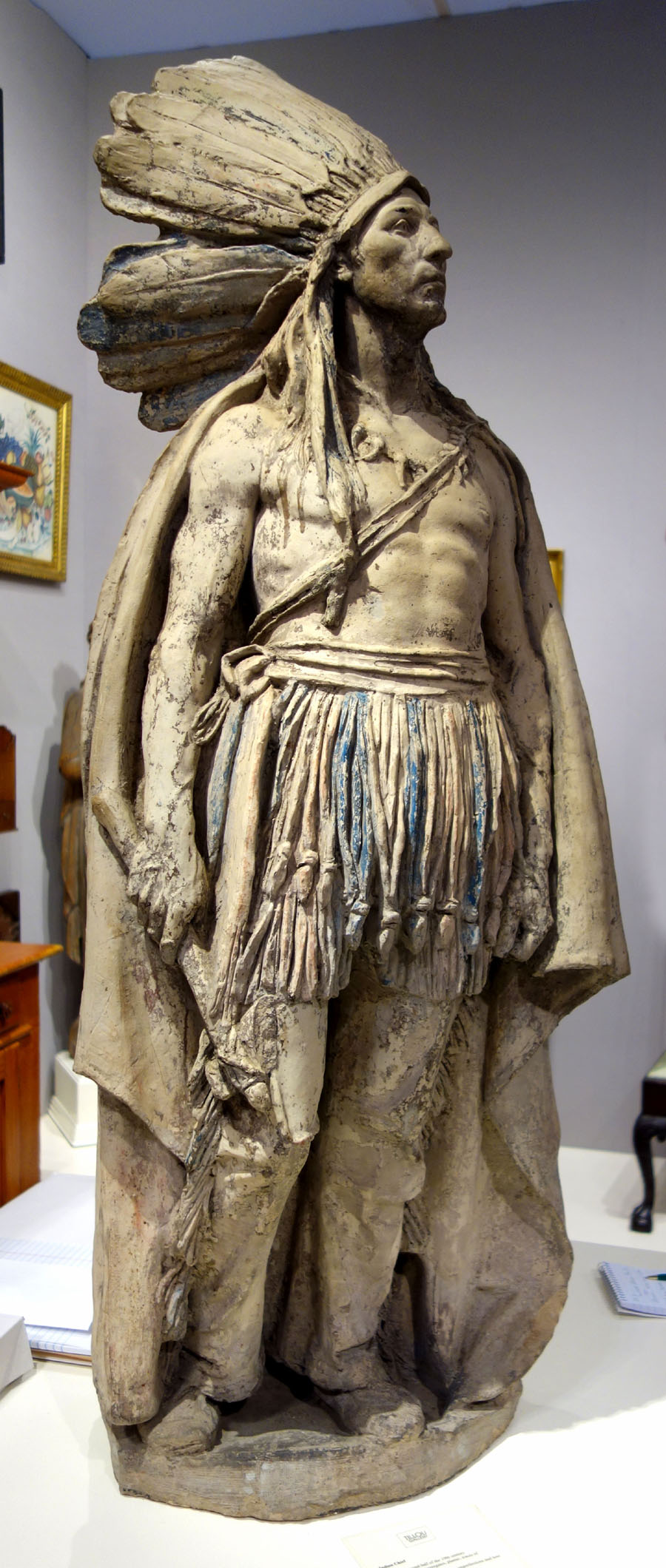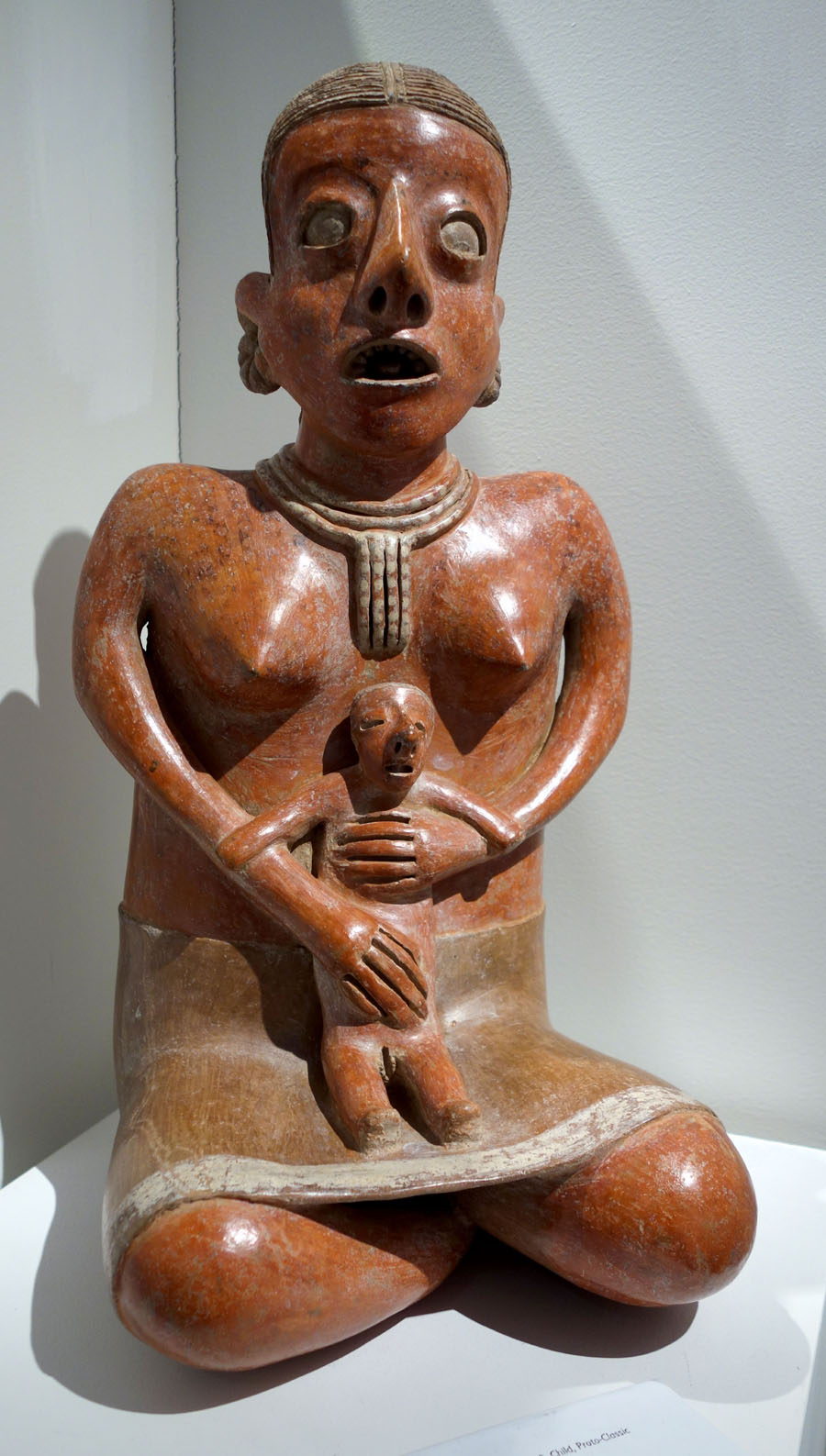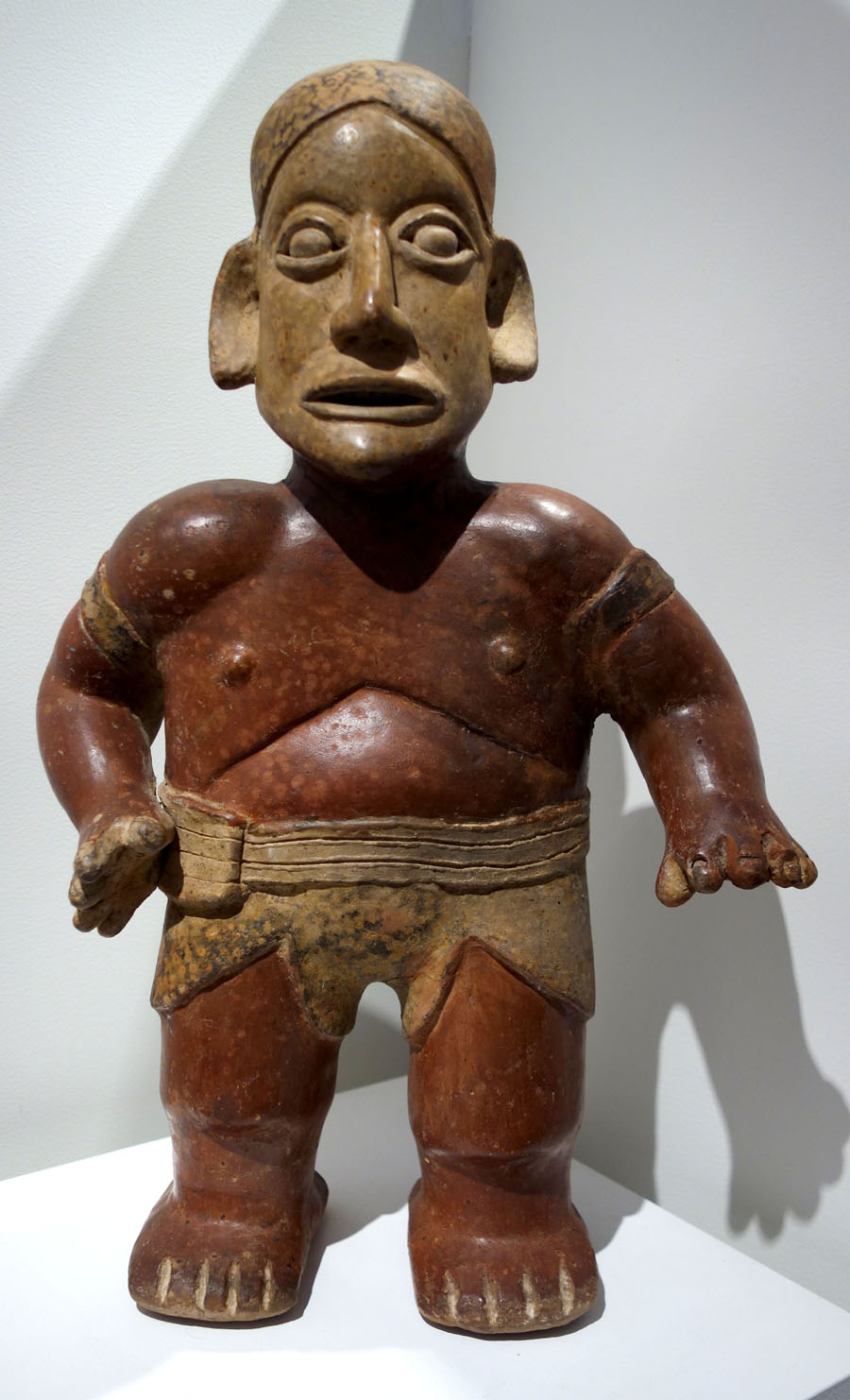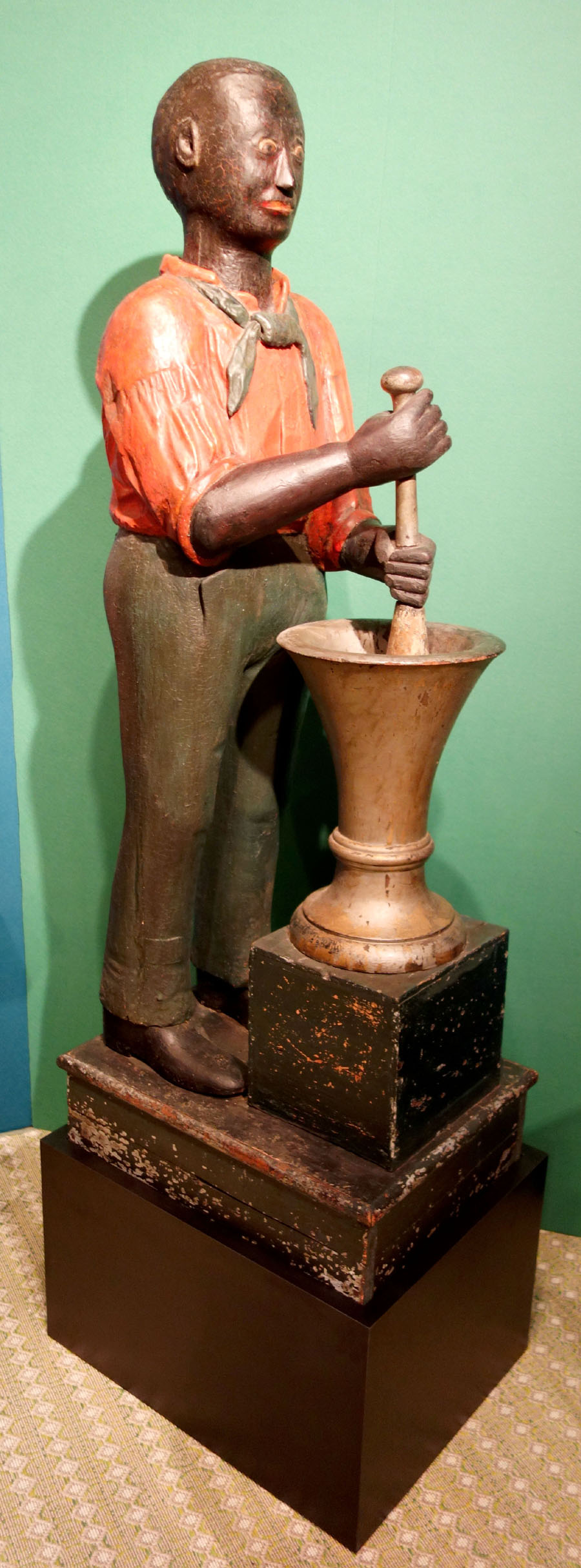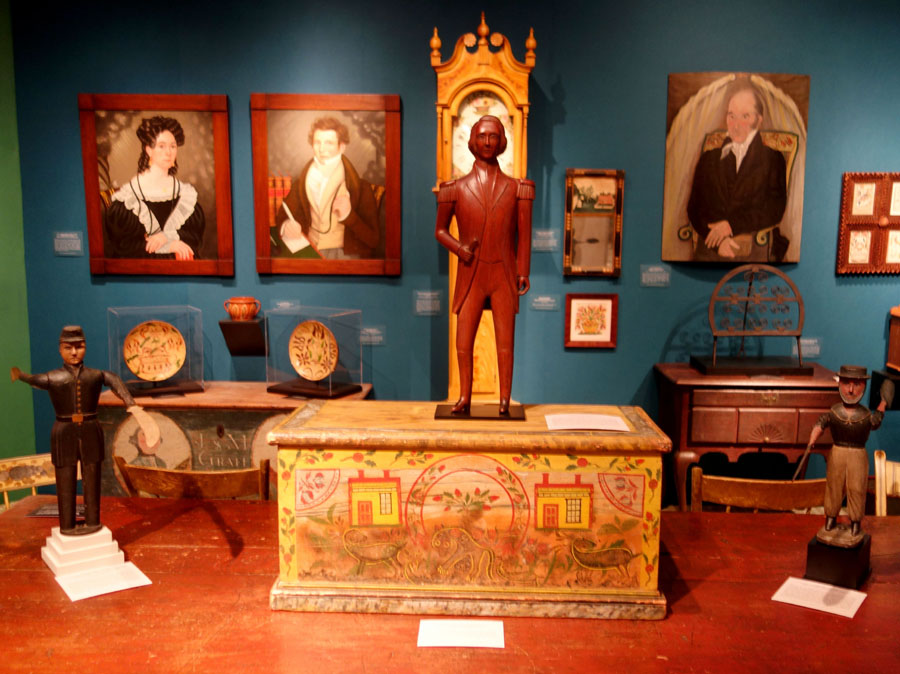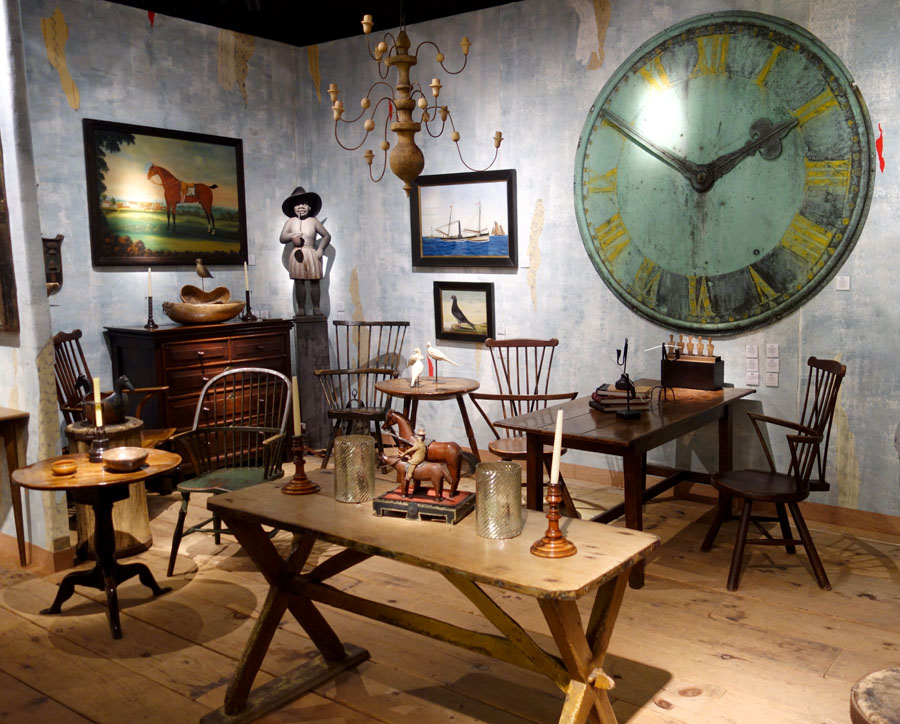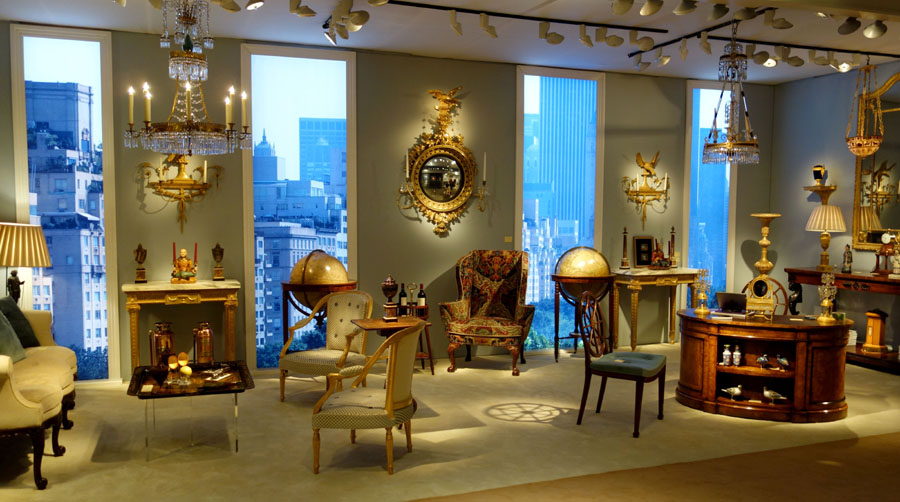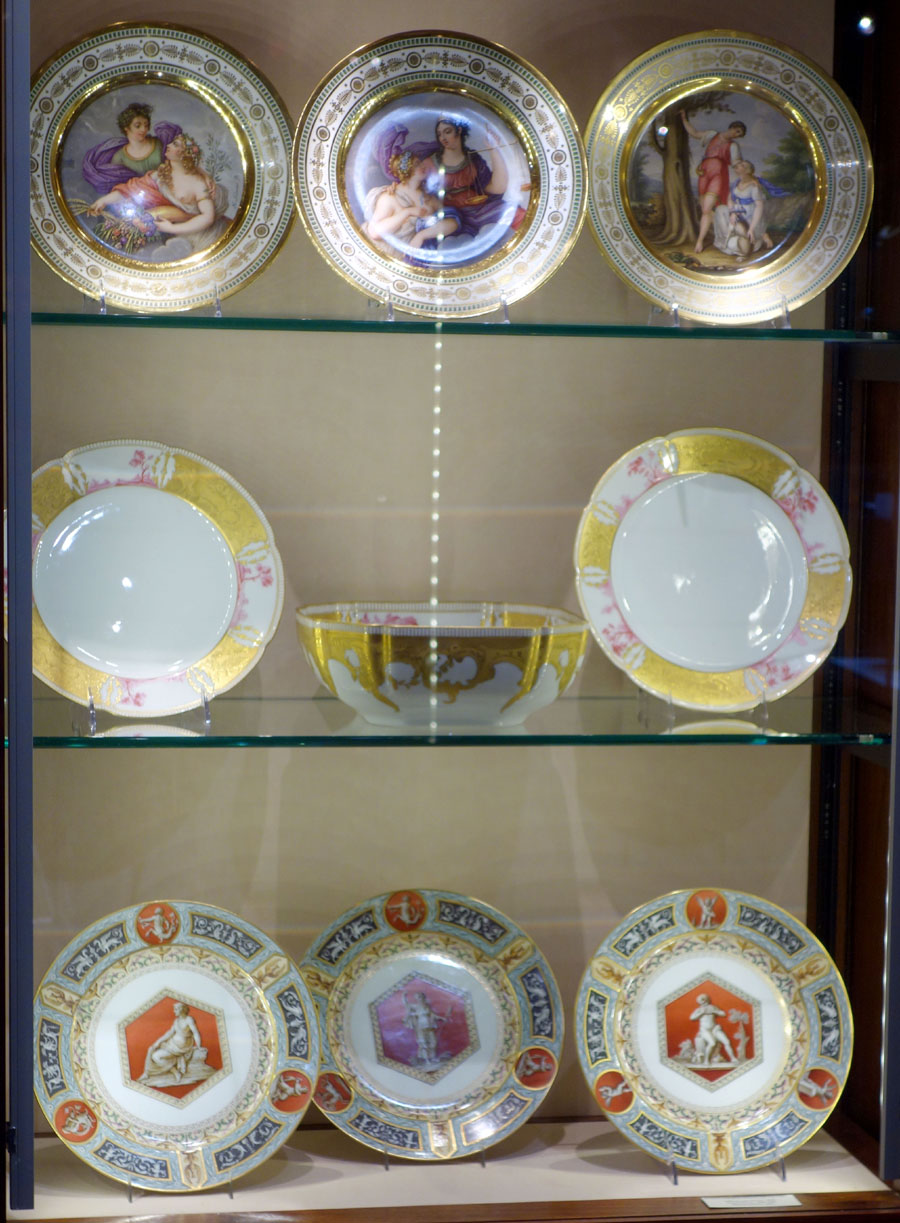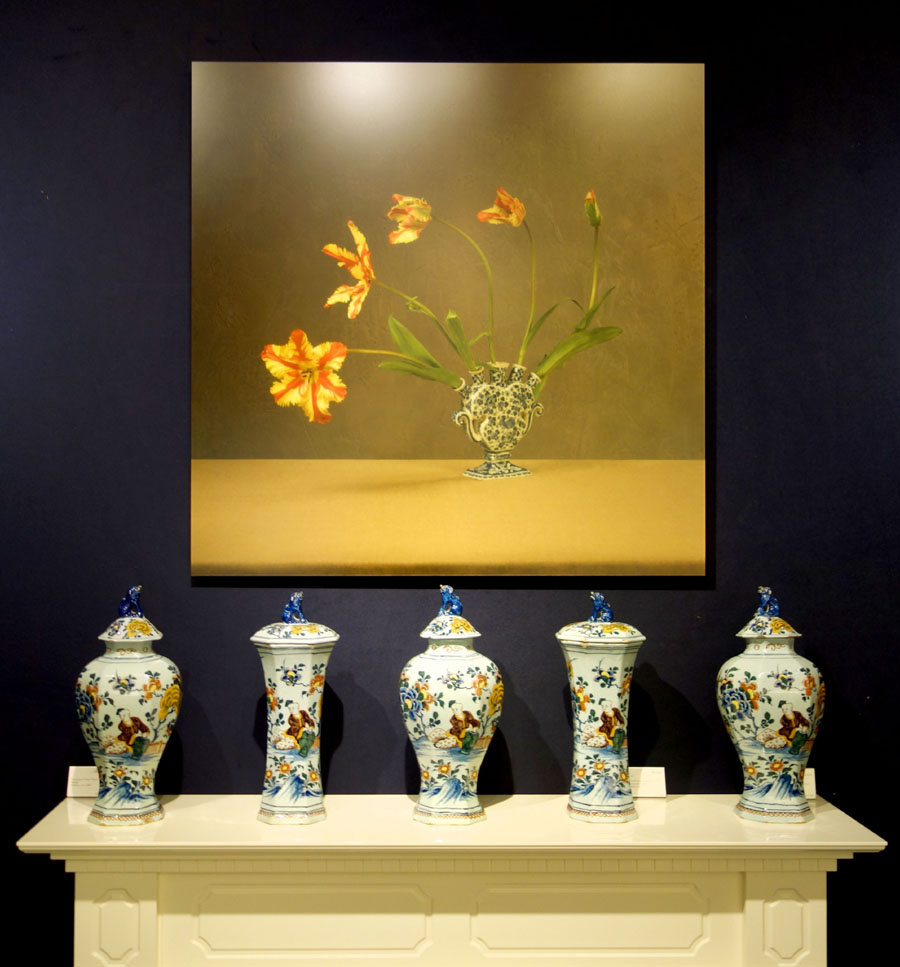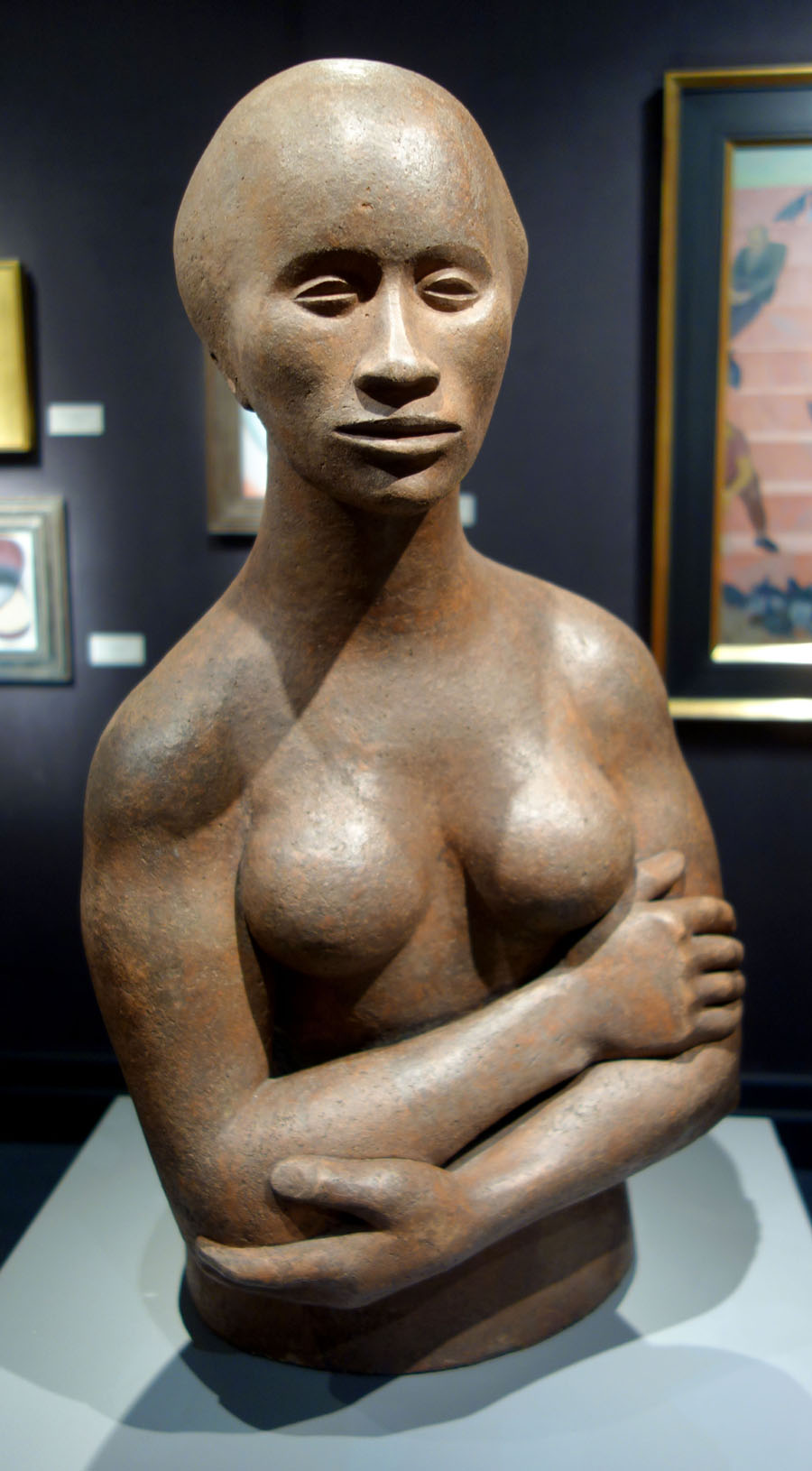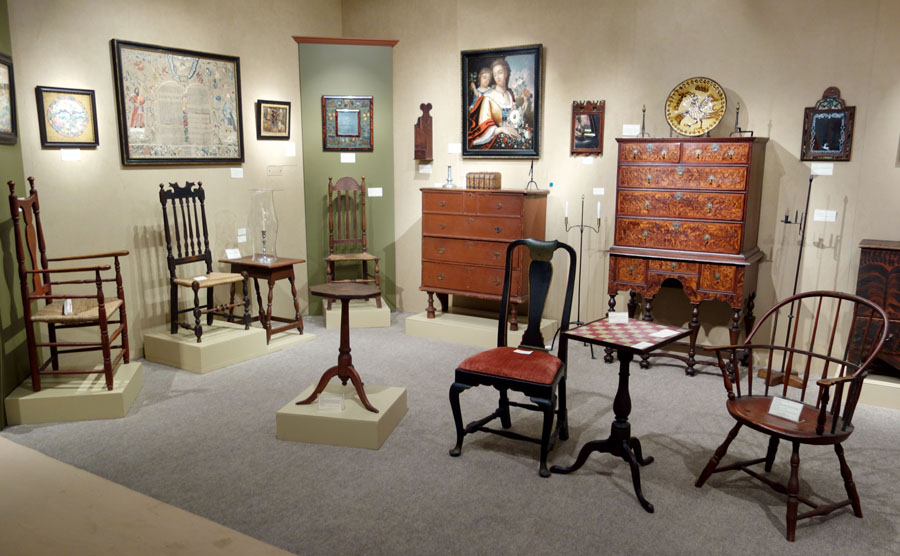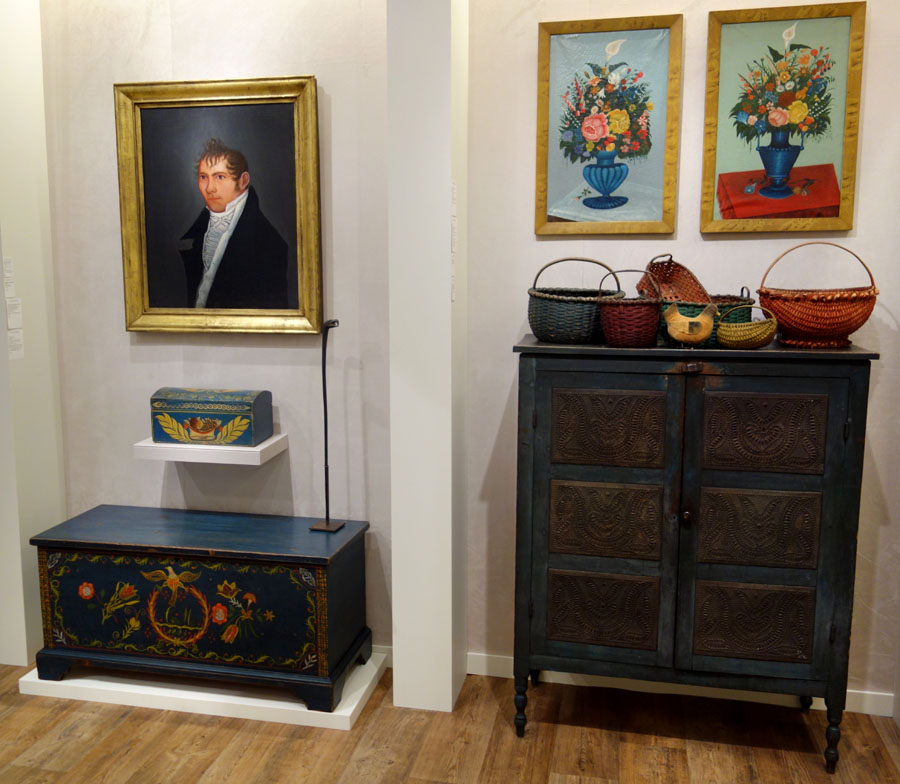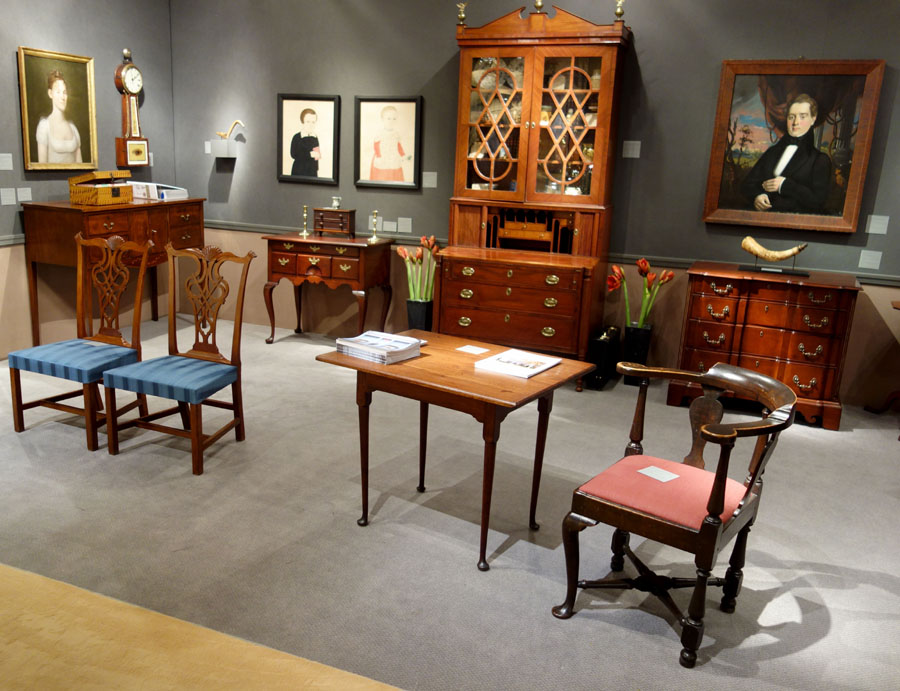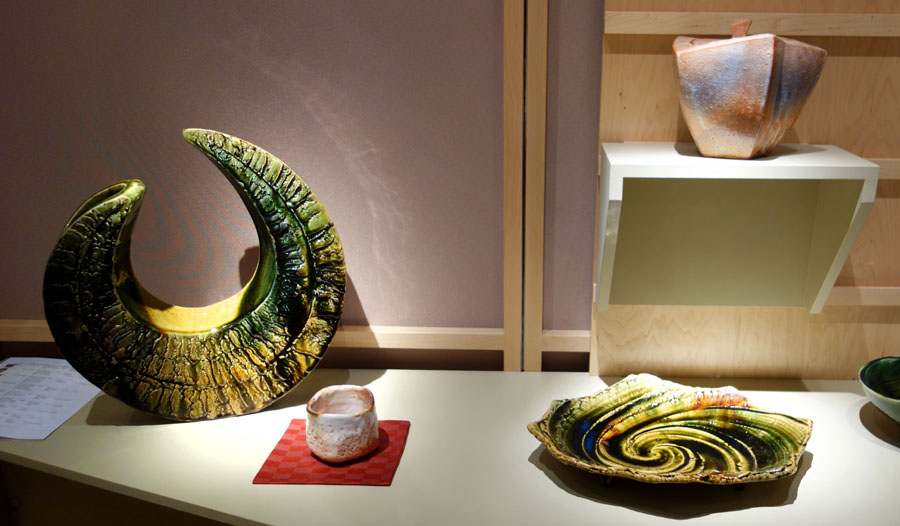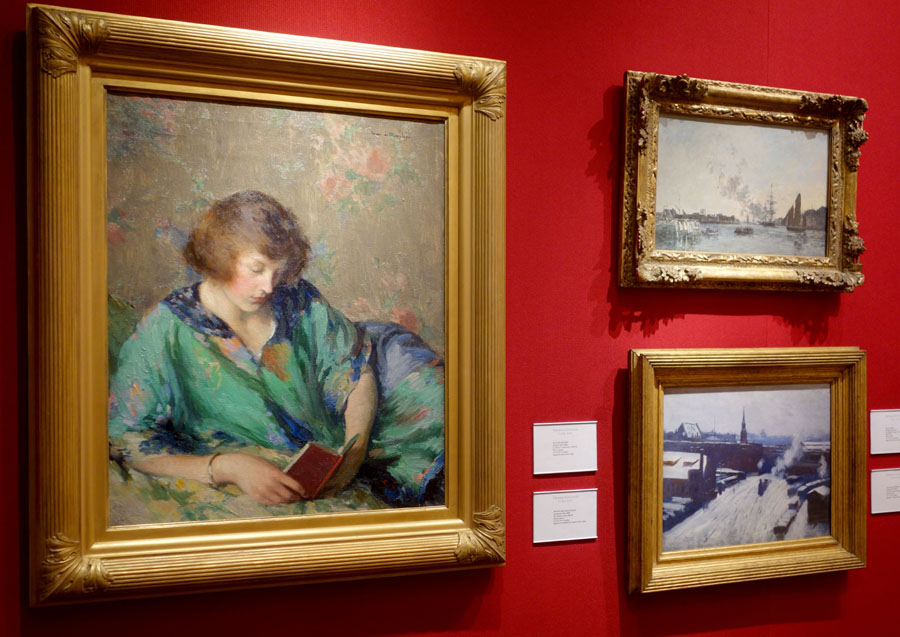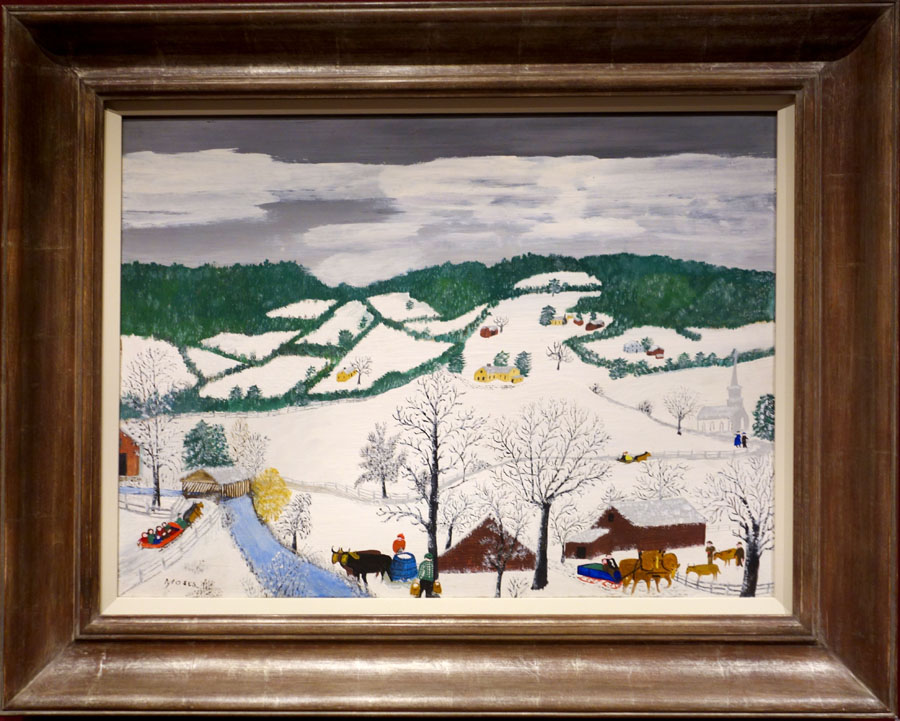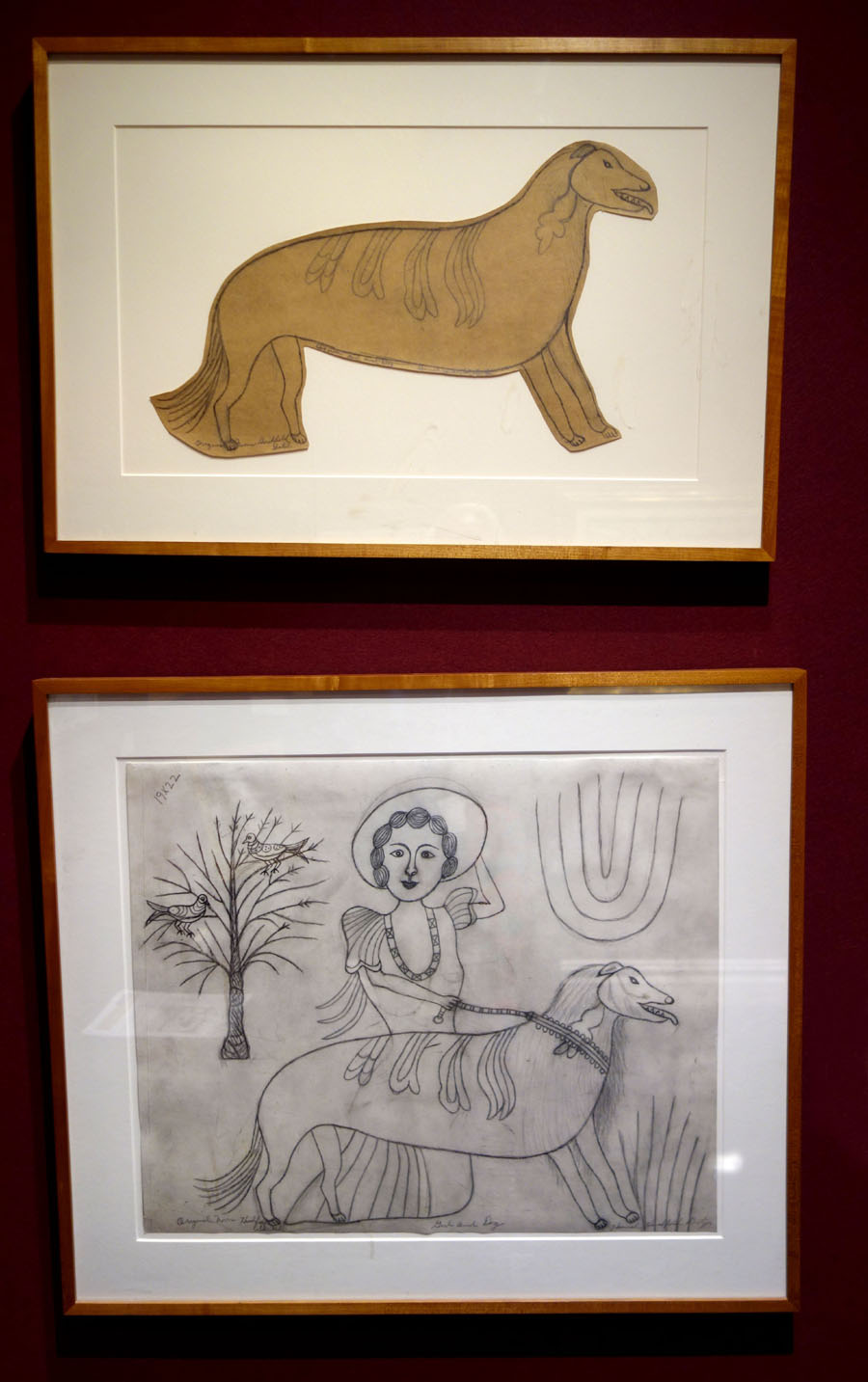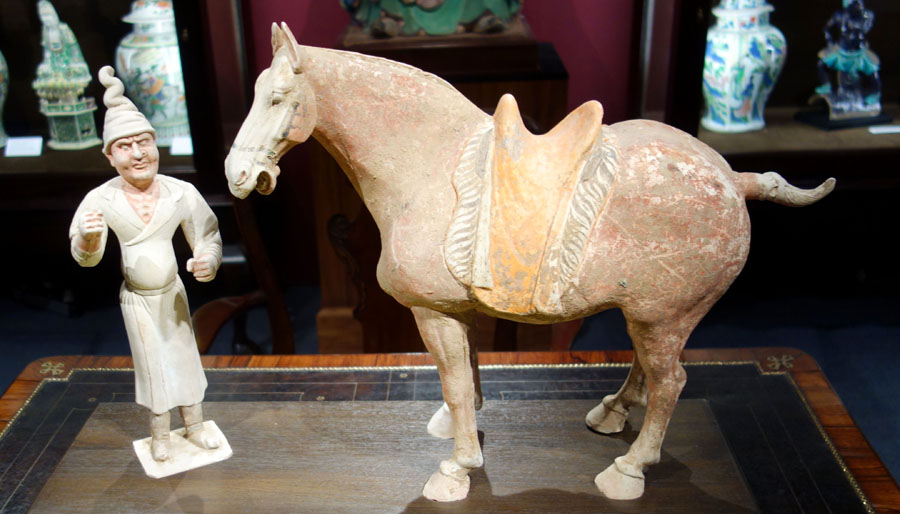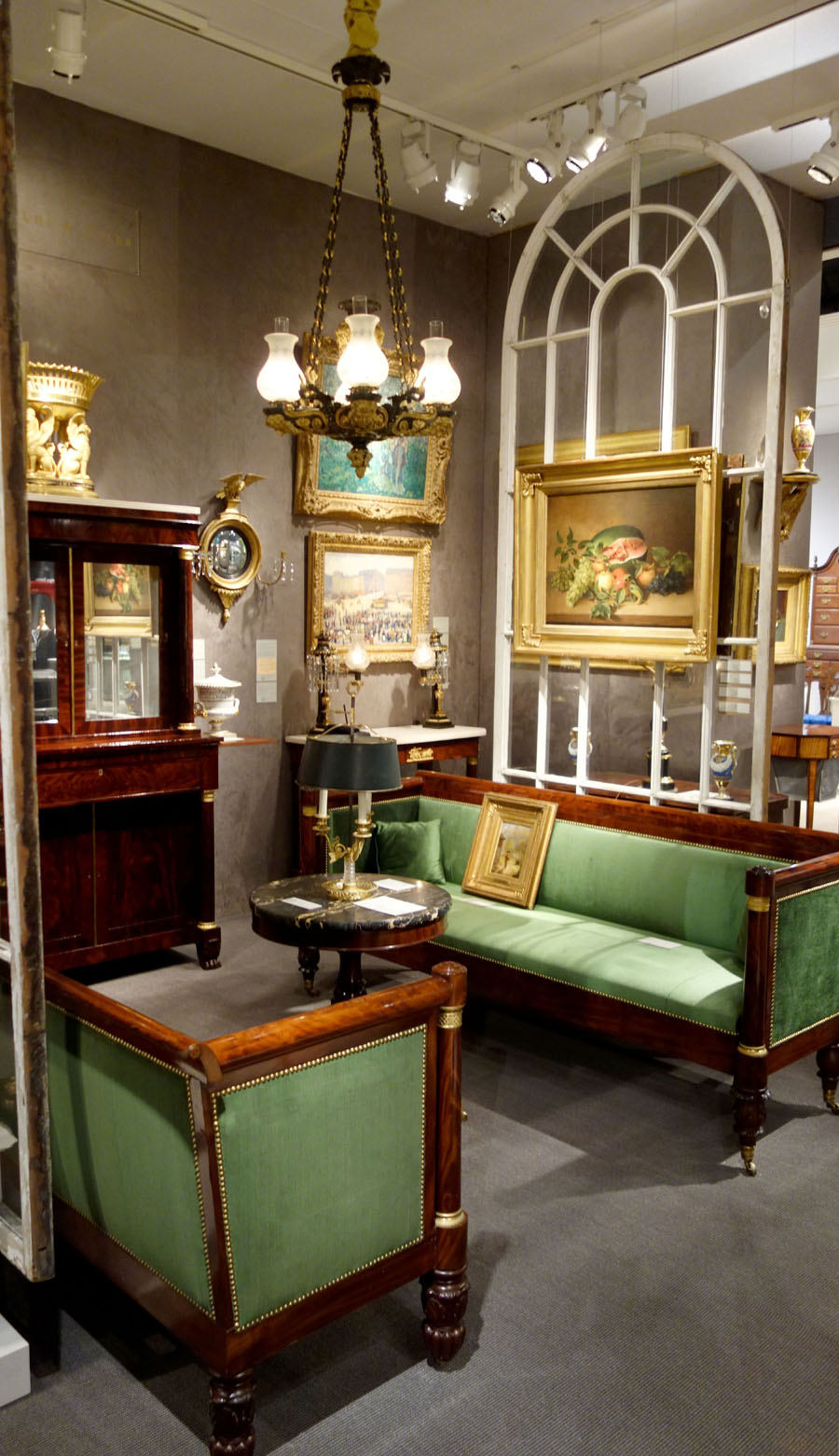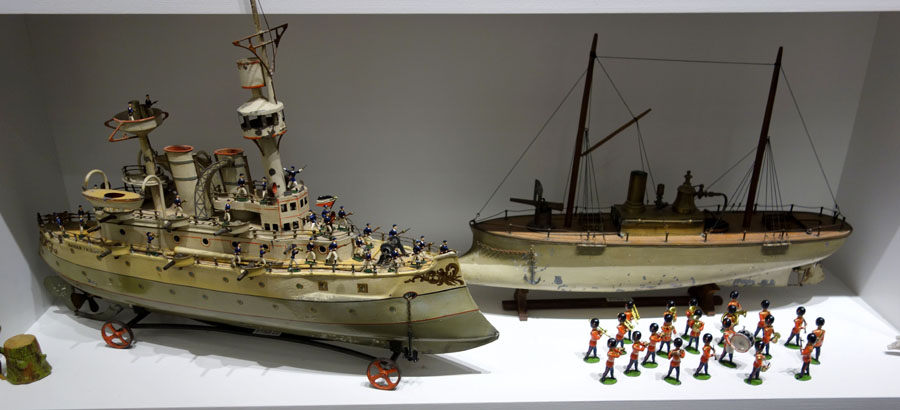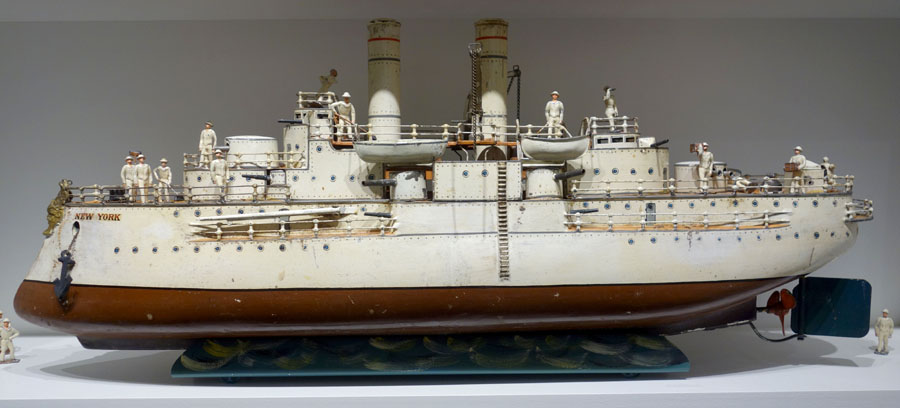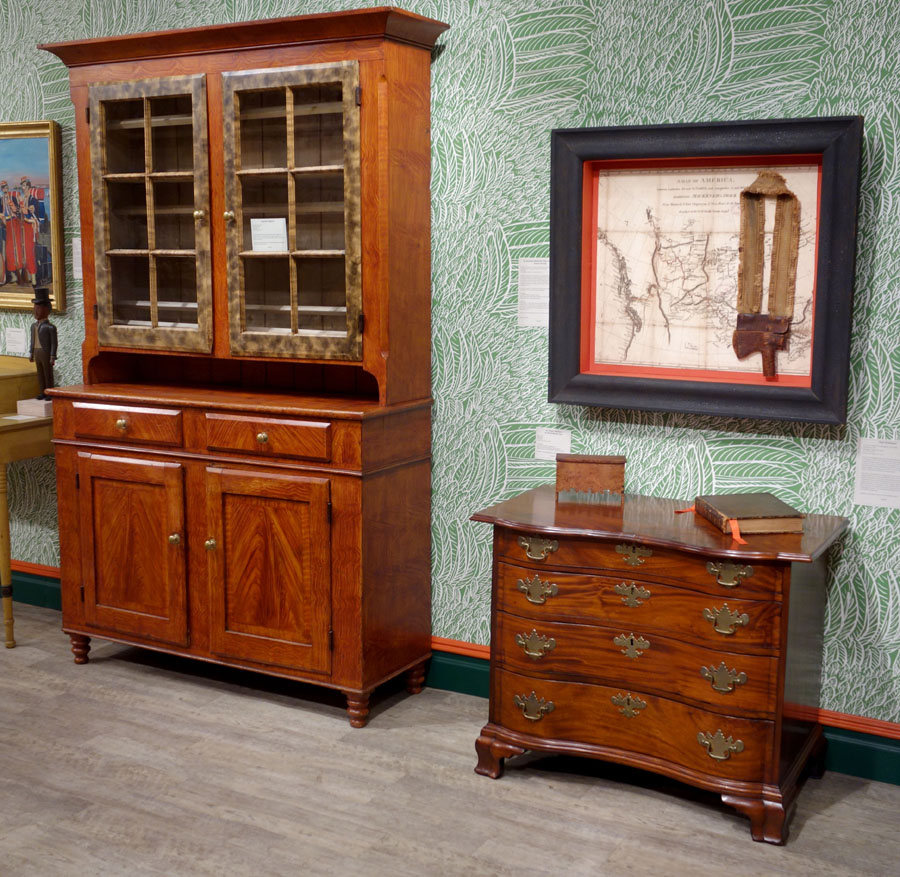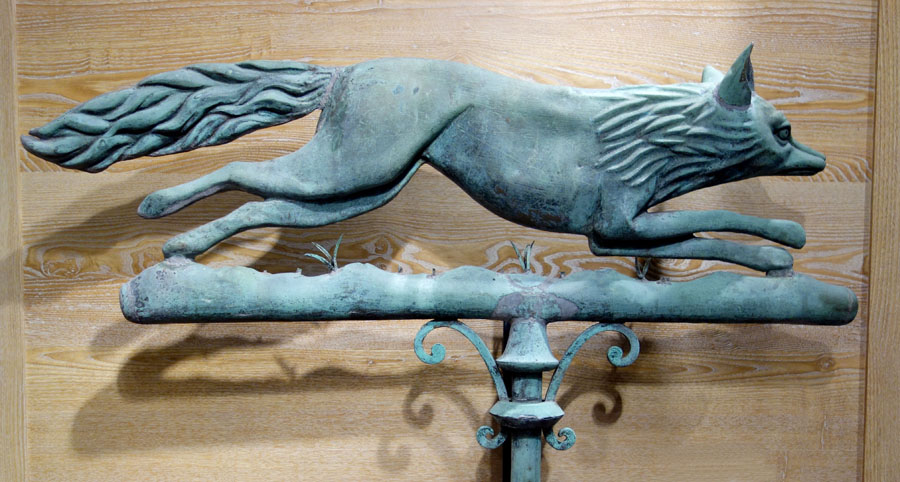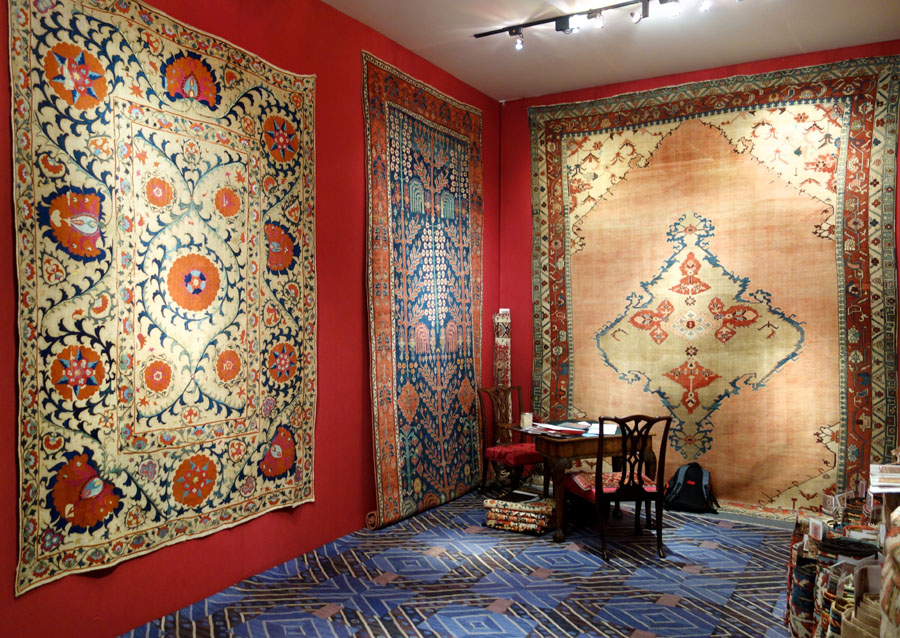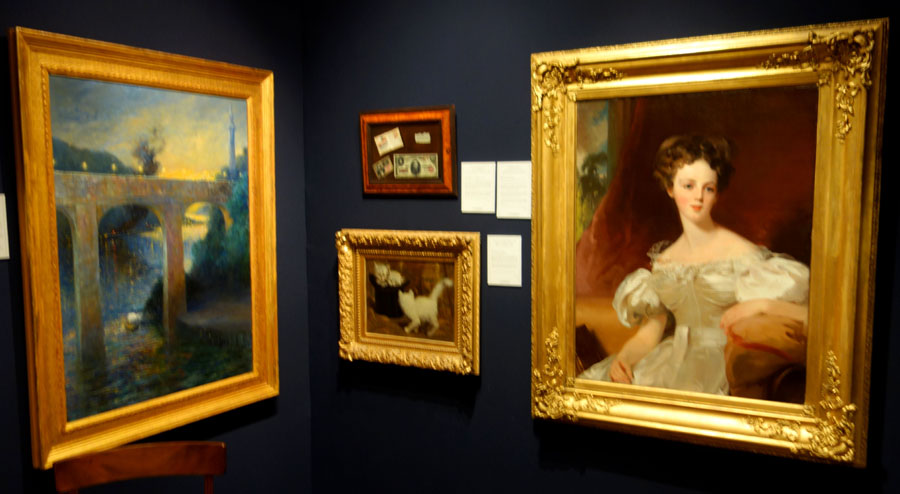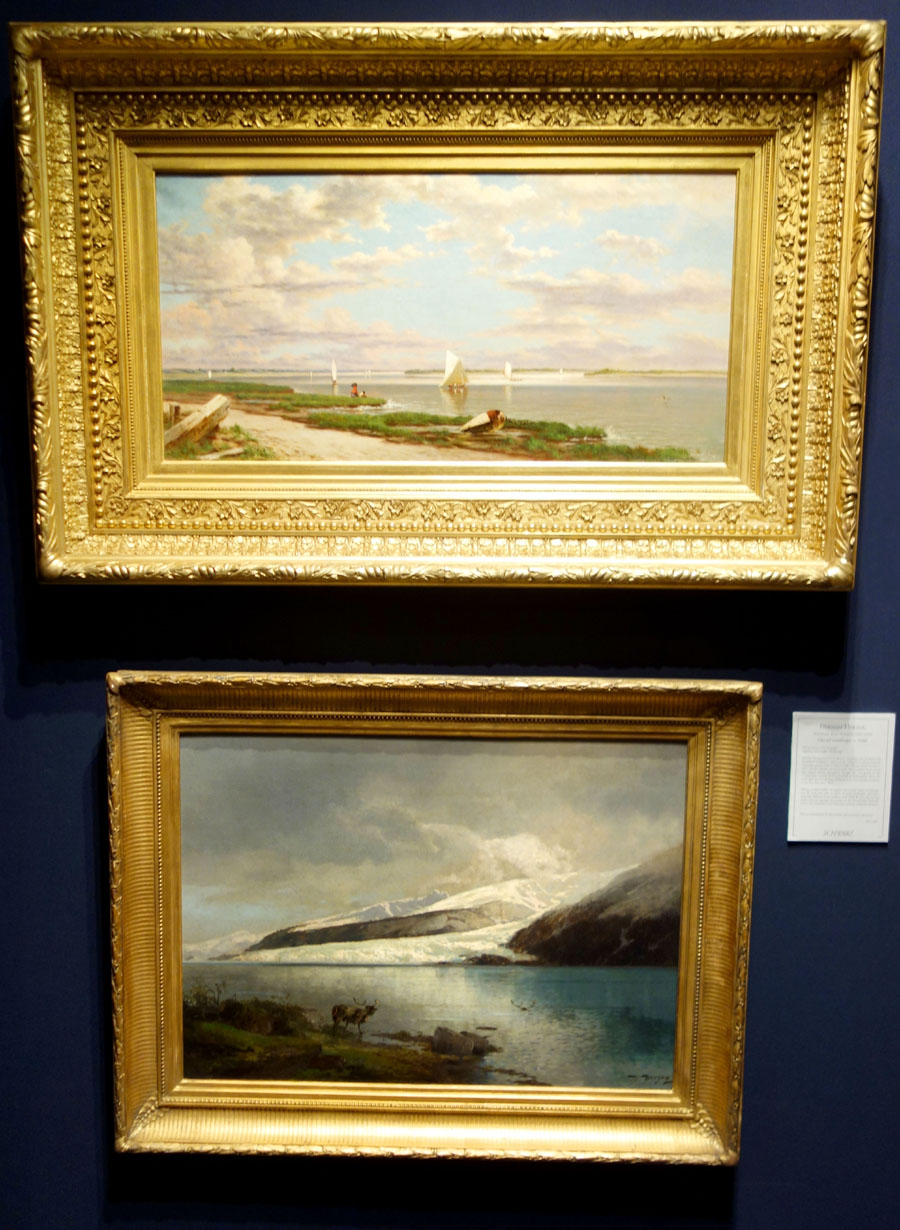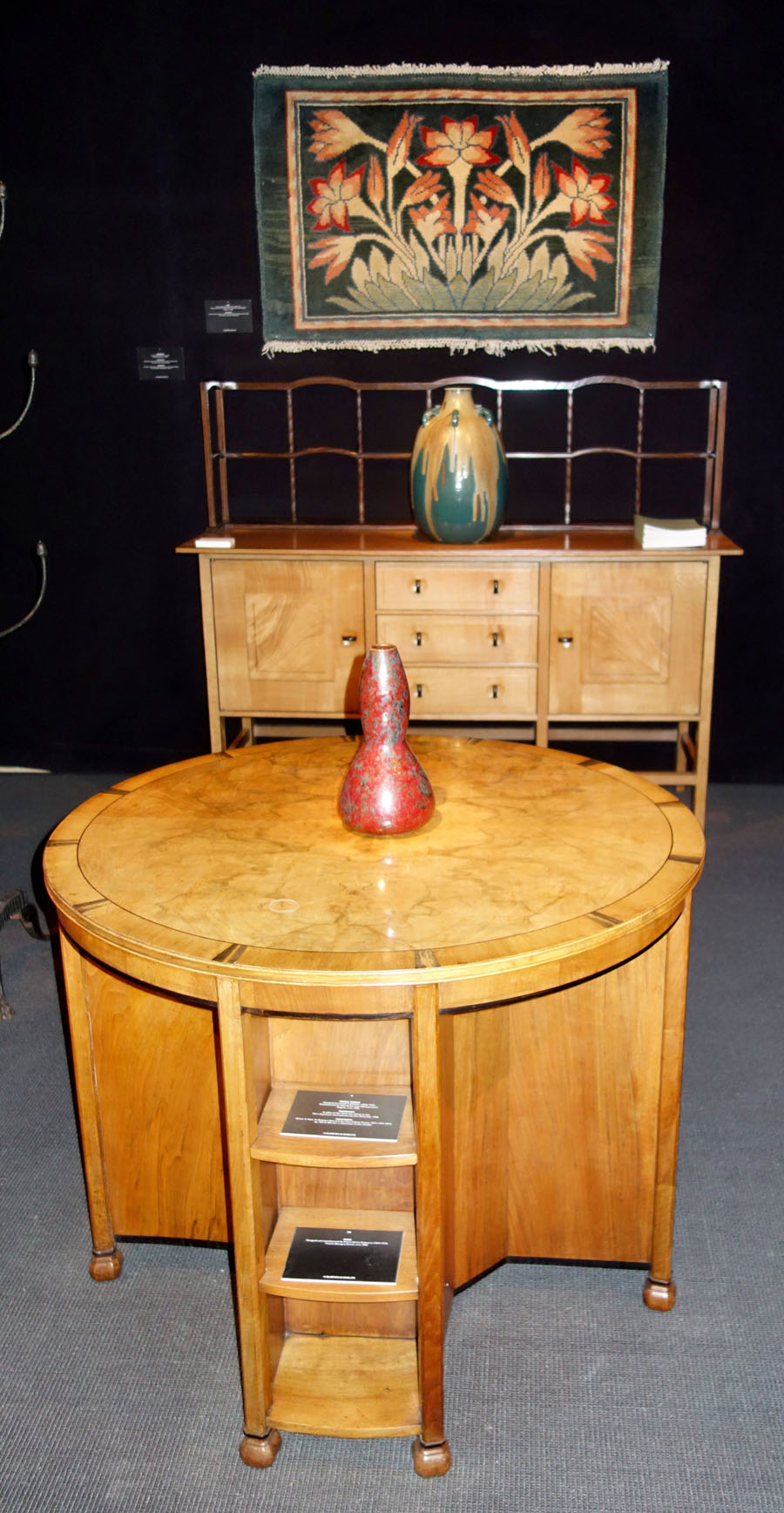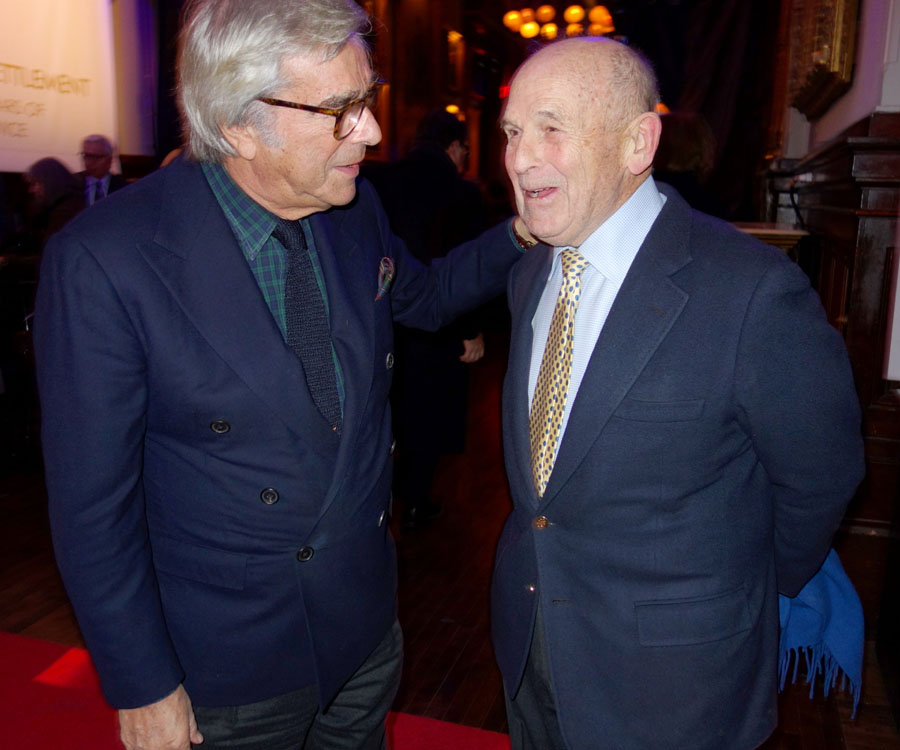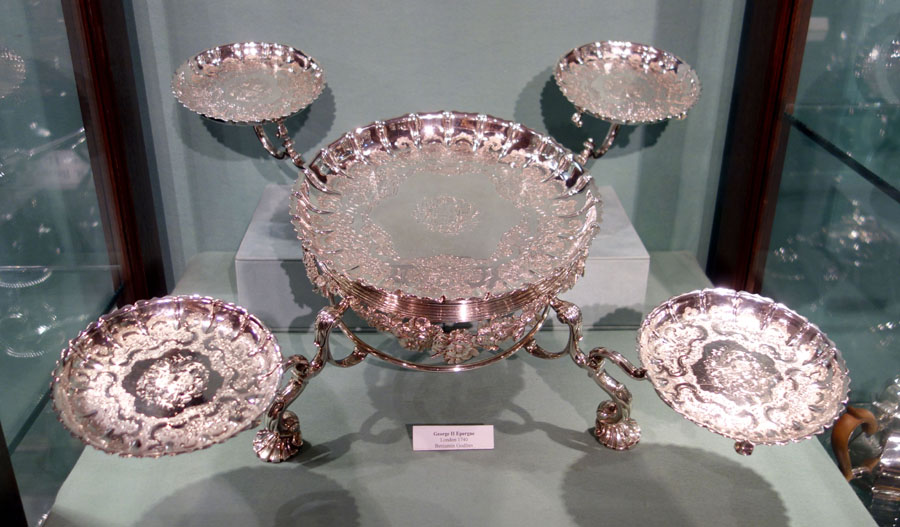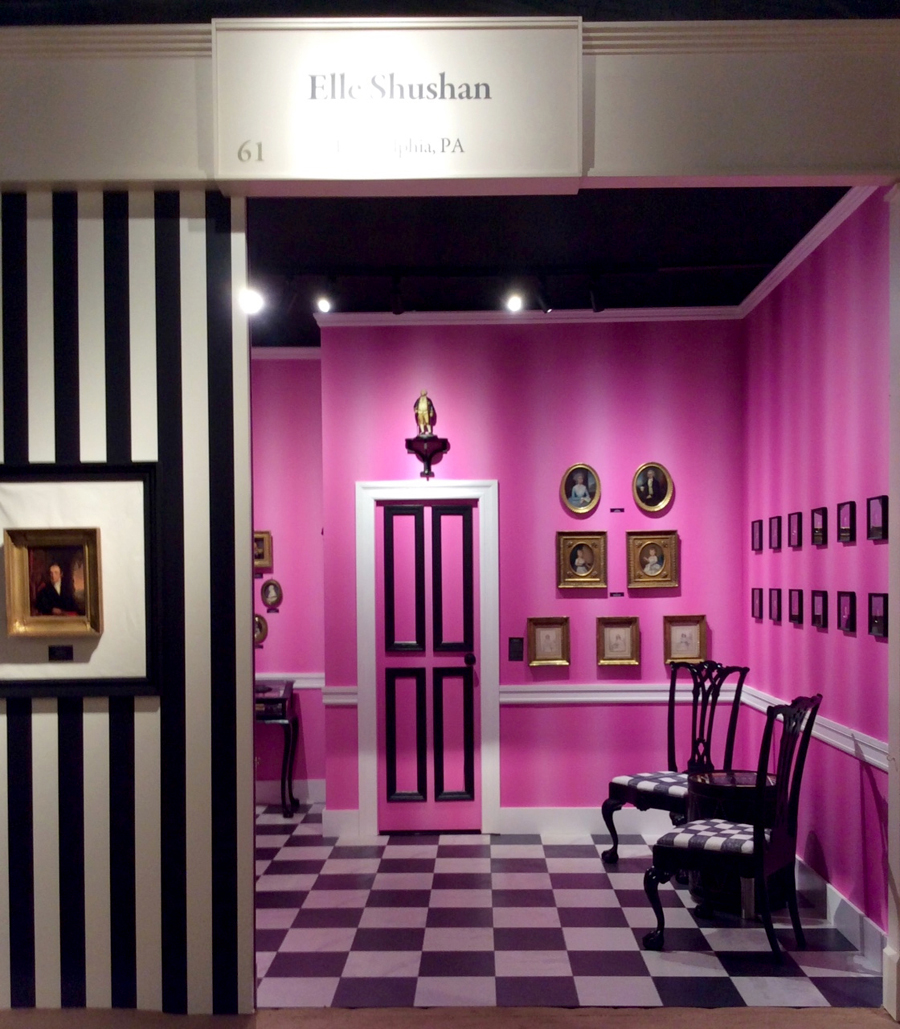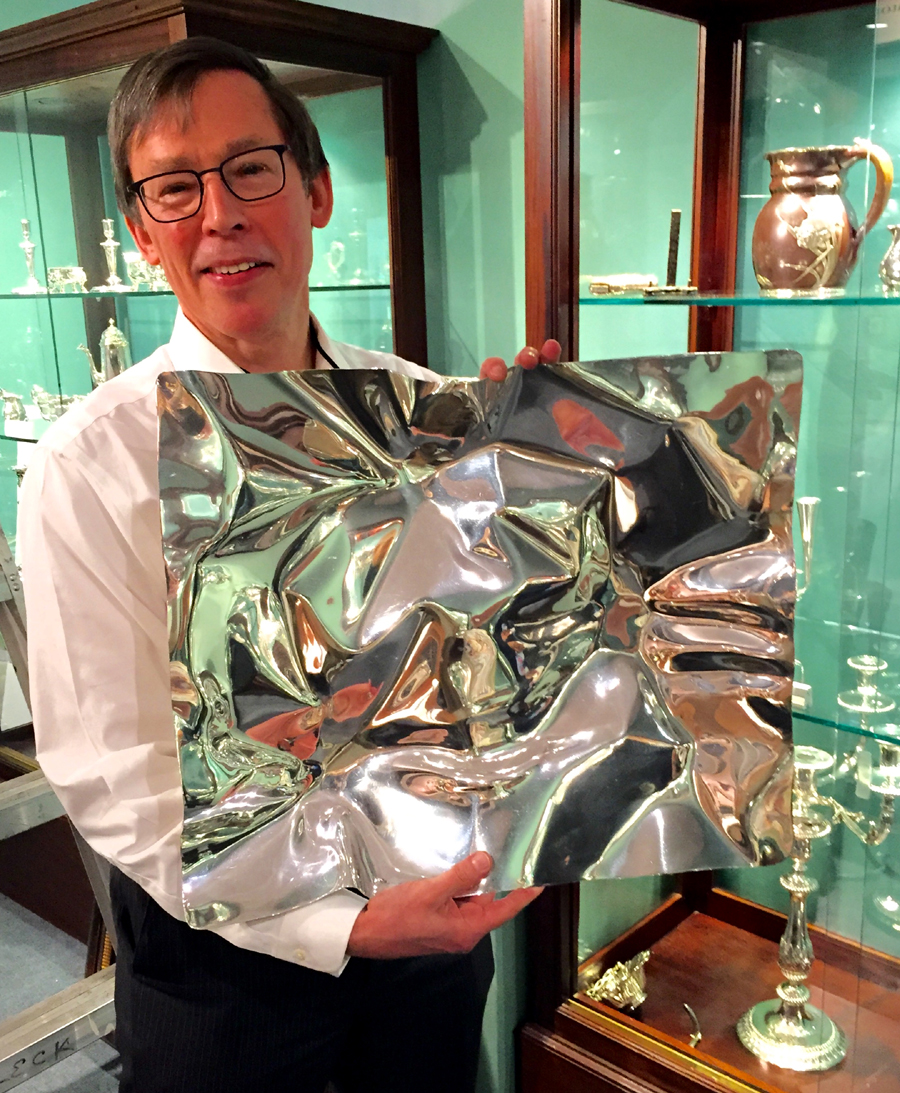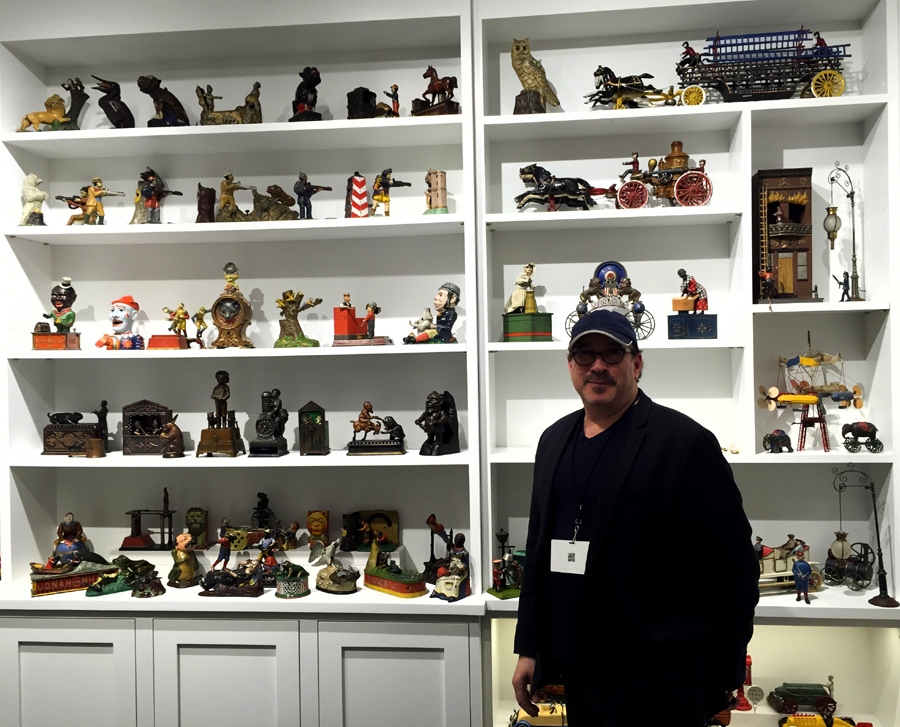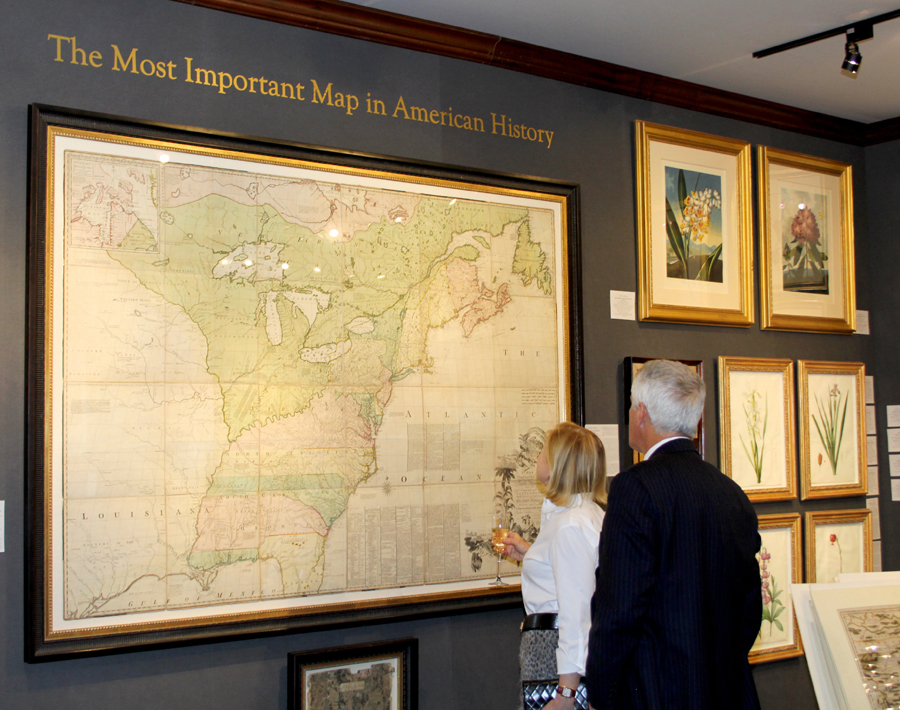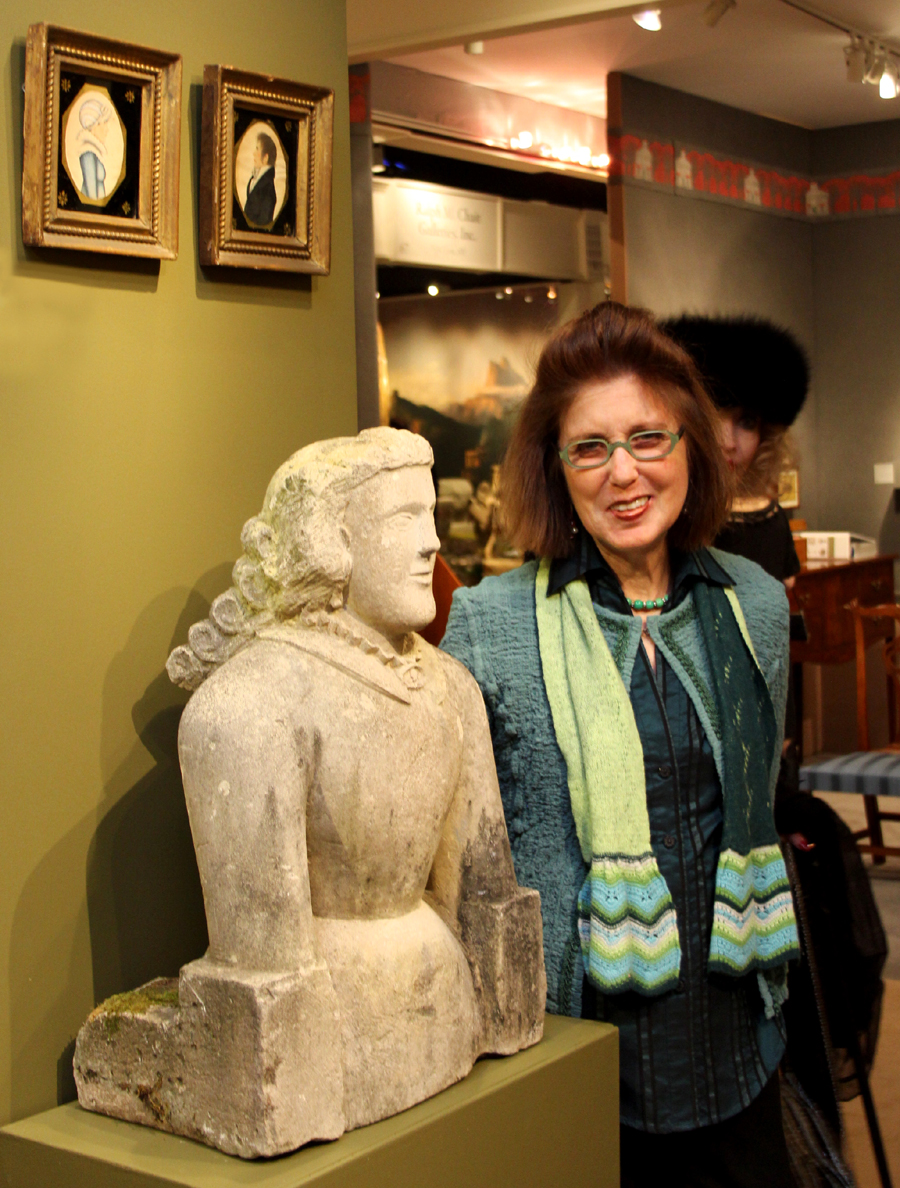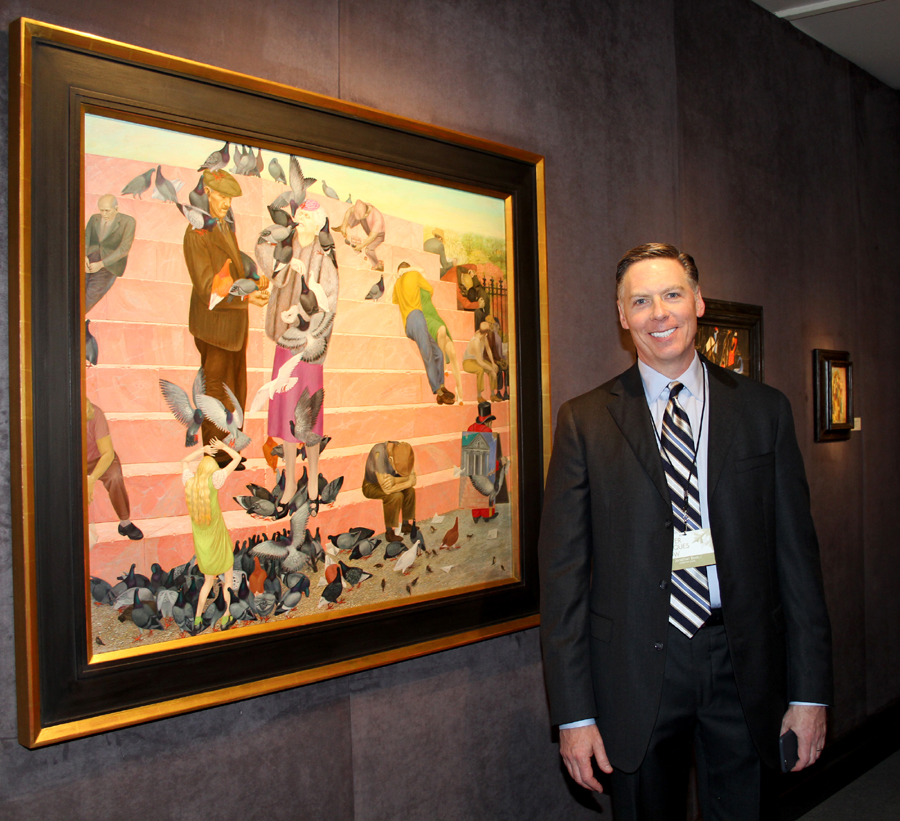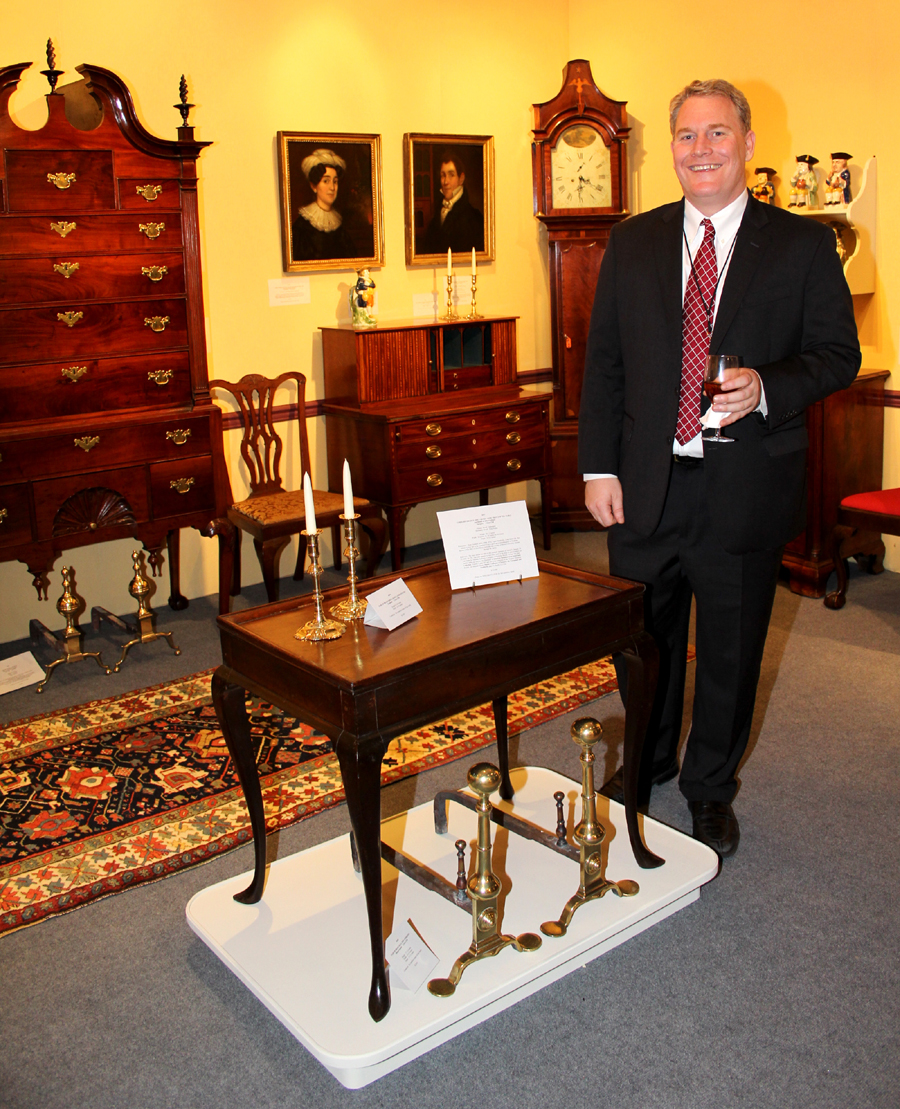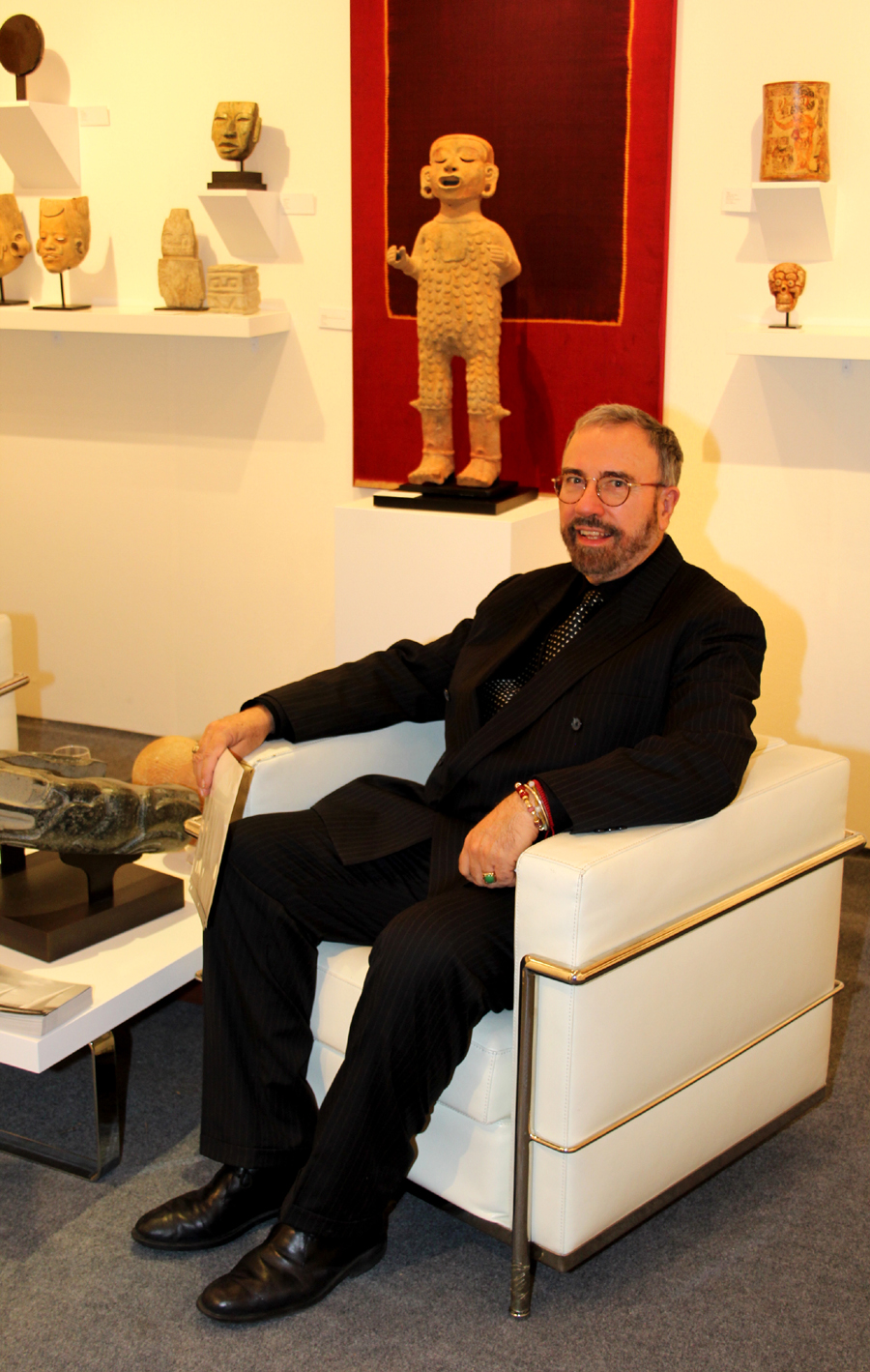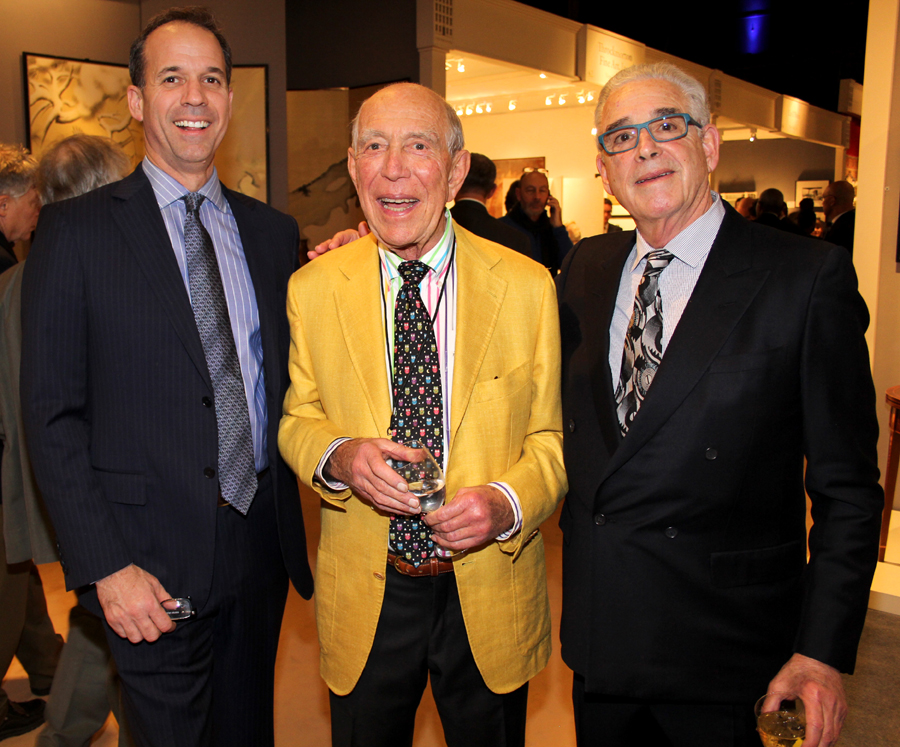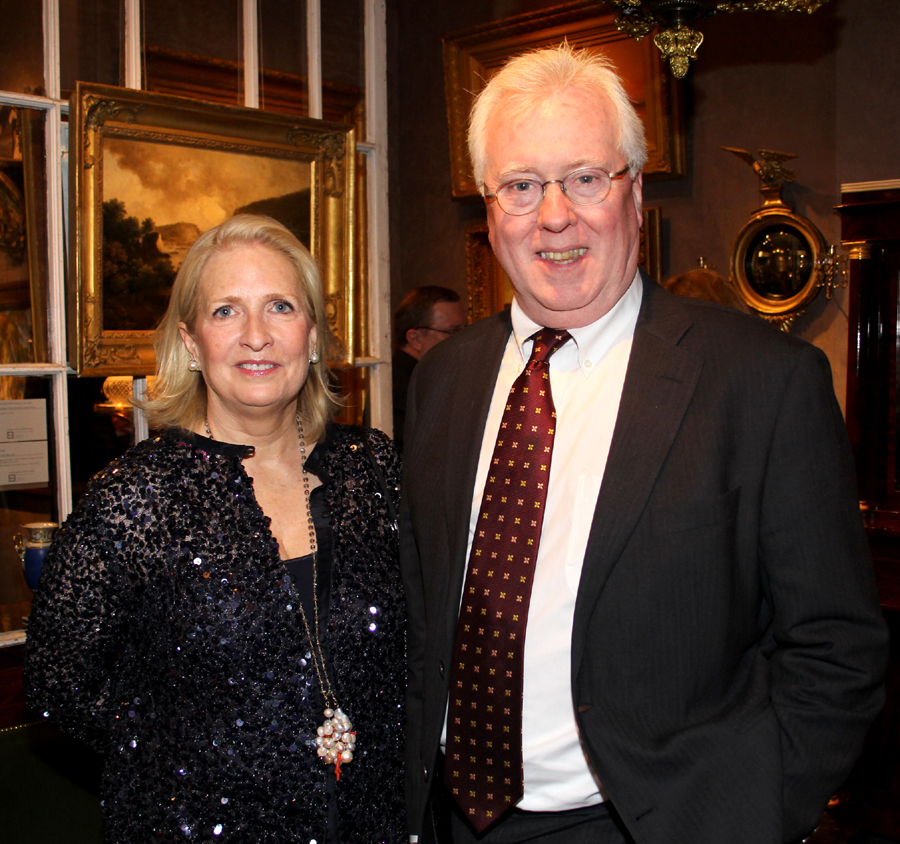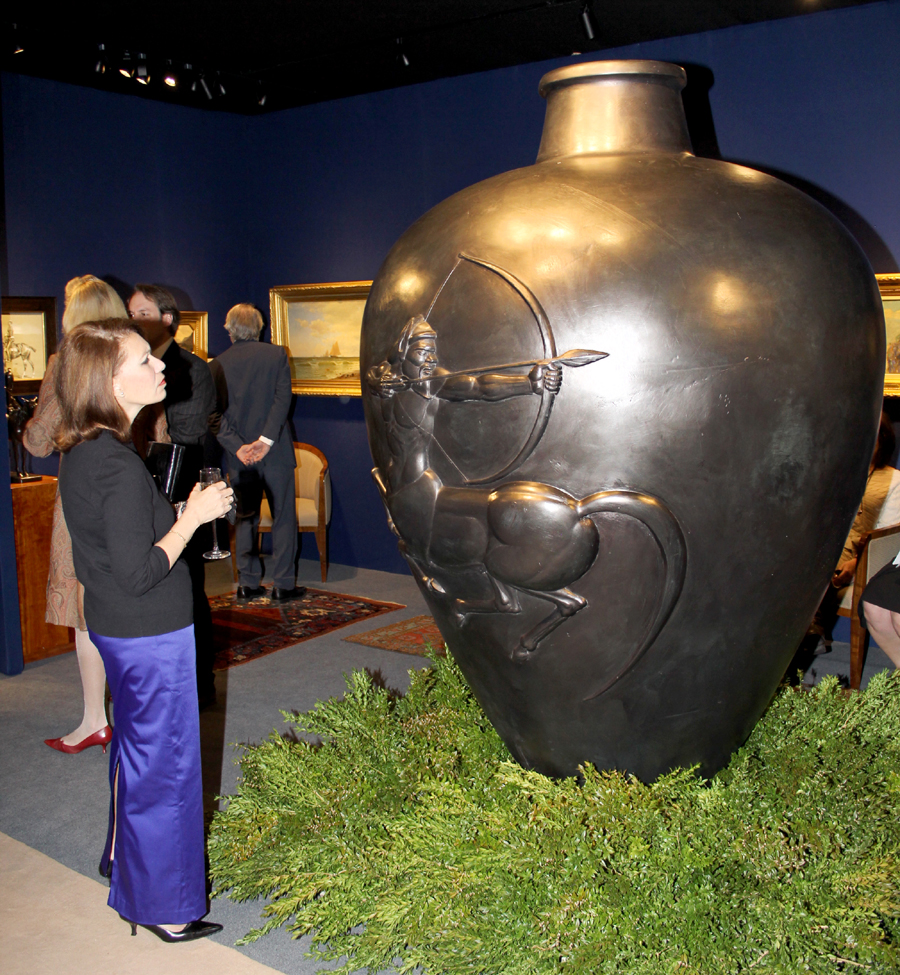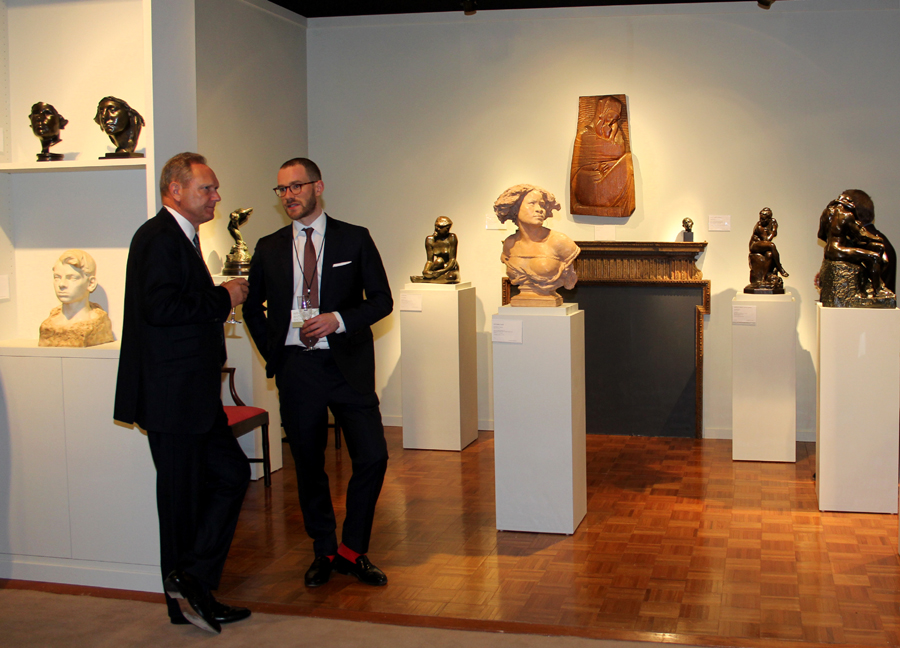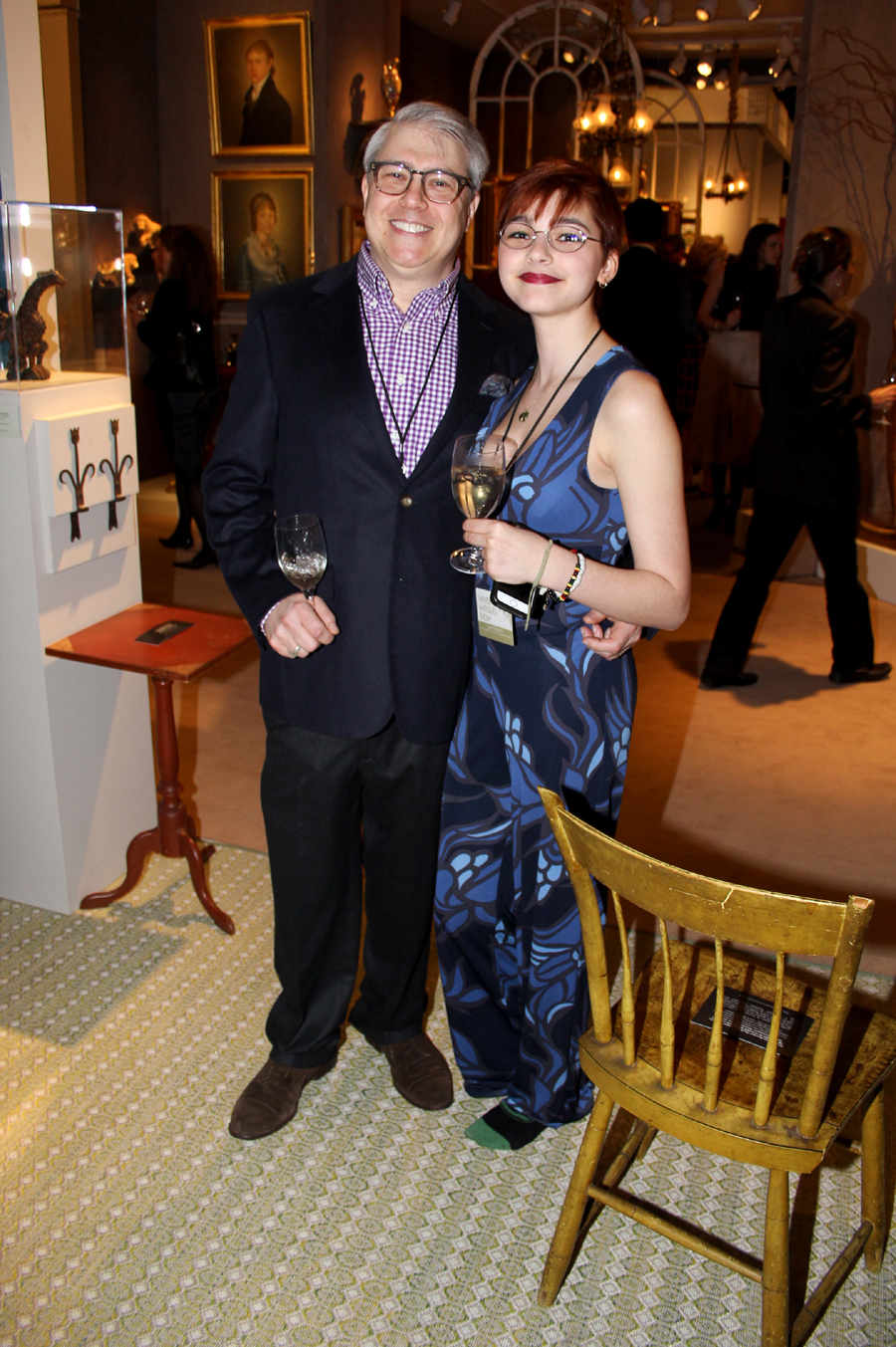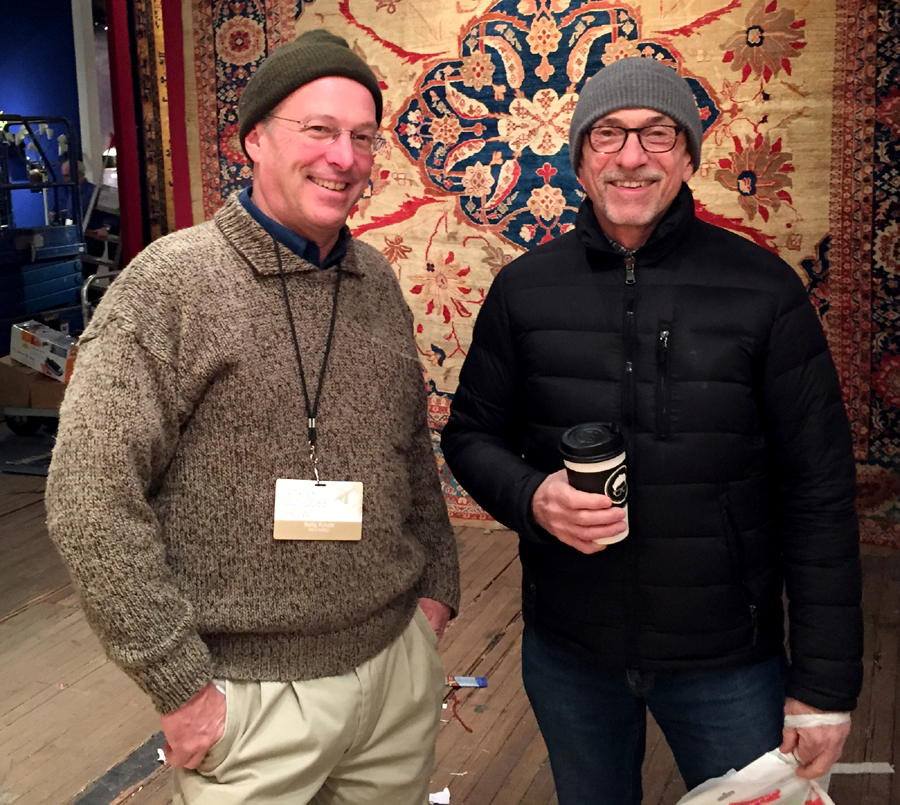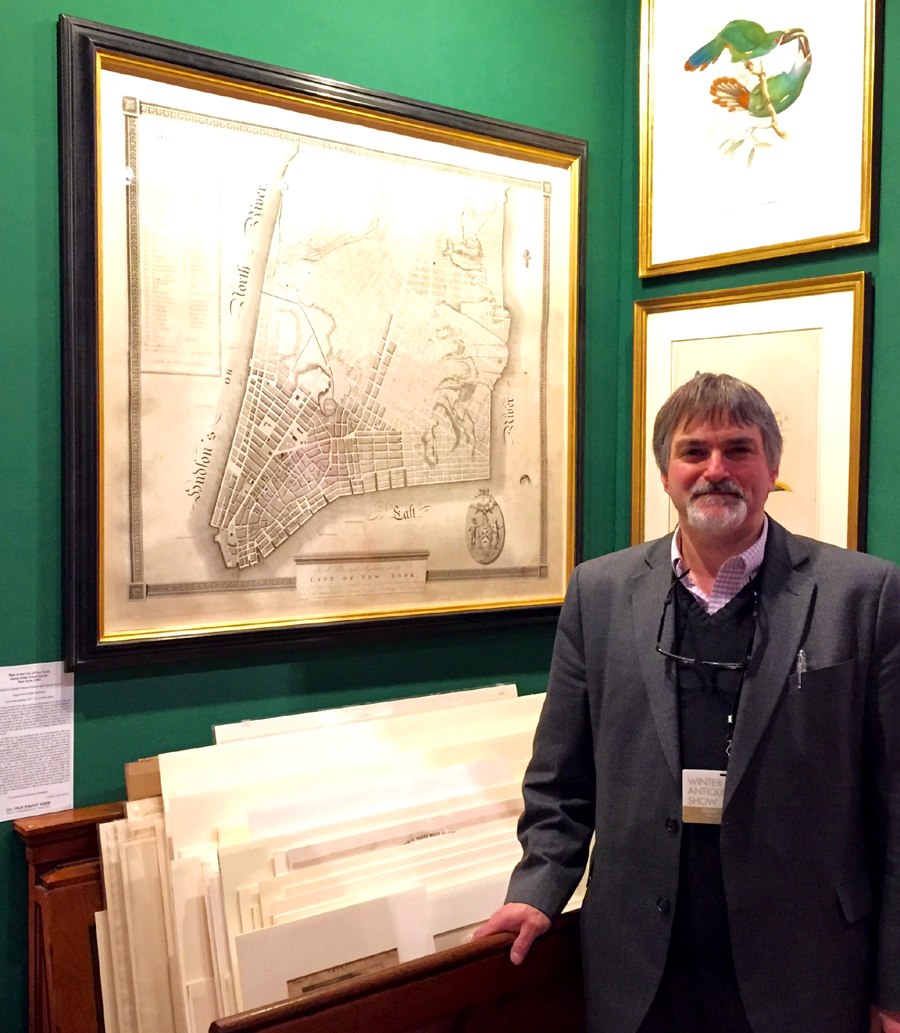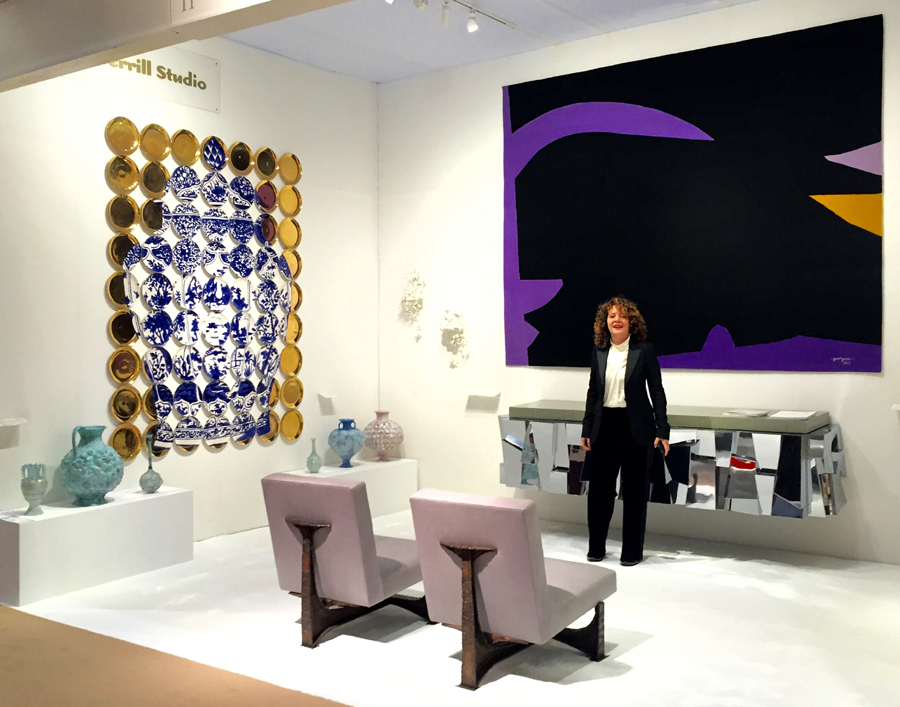Virtuoso Performances Contributed To The Symphonic Whole, Even As Snow Shut Down The City
Review by Laura Beach
Photos by R. Scudder Smith and Laura Beach.
Additional photography by Neil Rasmus, Zach Hilty/BFA.com, courtesy Winter Antiques Show
NEW YORK CITY — Acknowledging that working people have less time to spare these days, antiques shows are becoming concentrated, weekend affairs. The Winter Antiques Show is a notable exception. It runs at the Park Avenue Armory for two weekends with five long, leisurely days in between. The arrival of blizzard Jonas on Saturday, January 23, proved why having a spare weekend can be a good thing.
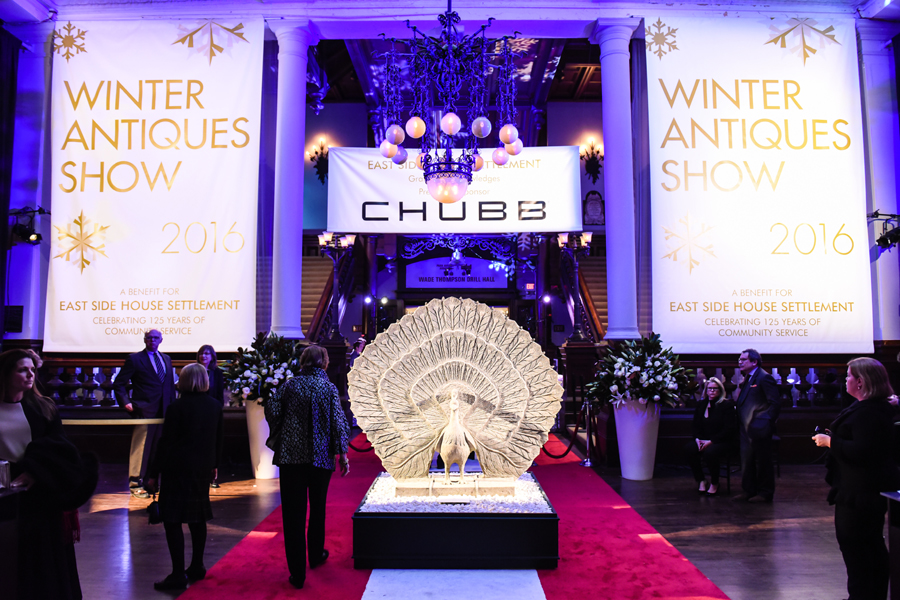
Opening night at the 62nd Winter Antiques Show. Barbara Israel supplied the circa 1930 Chinese granite peacock.
Jonas was a sock in the jaw for exhibitors. Racing to beat the snow, many buyers left town after the fair’s glamorous opening night party on Thursday, January 21. More than ever, the success of this year’s show will be determined in coming weeks, as dealers follow up with their clients.
Everyone credited the show’s executive director Catherine Sweeney Singer with skillful management of the disruption. After a citywide travel ban was put in place at 2:30 pm on Saturday, management kept the show open until 6 pm, closing two hours early.
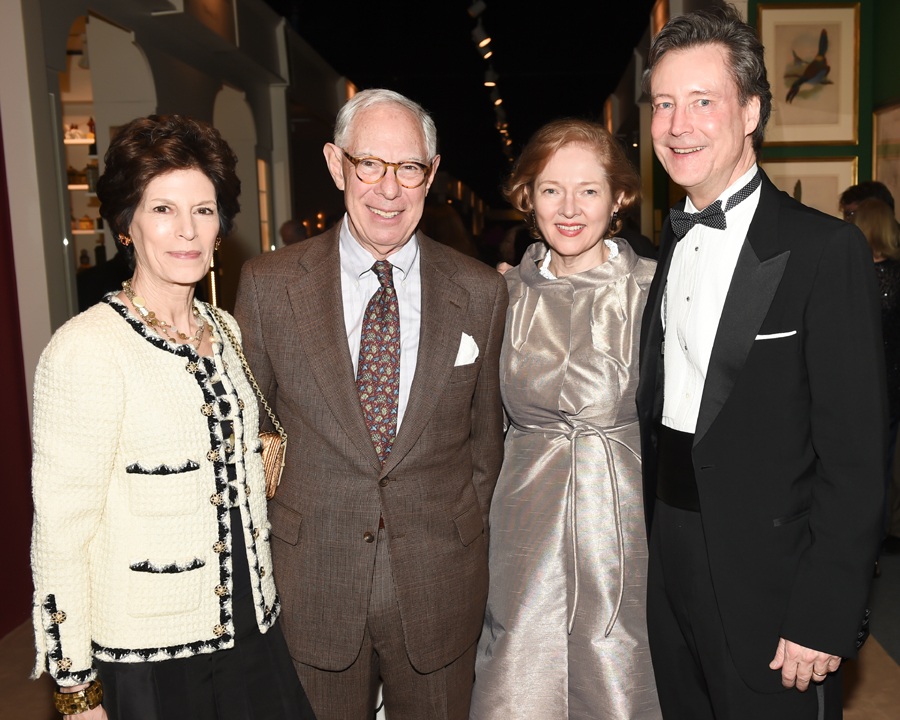
From left, Coco Kopelman, Winter Antiques Show Committee Co-chair Arie L. Kopelman, Executive Director Catherine Sweeney Singer and William Singer.
“I think generally there was a feeling of defiance in the hall and also a sort of childish glee about the magical beauty of that mass of snow, so powerful that it closed New York to all traffic and created a vast playground in the silent city,” said London dealer Robert Young.
“Neighborhood people continued to come in. We made two sales during that period, so it was worth being open,” said Edwin Hild of Olde Hope Antiques.
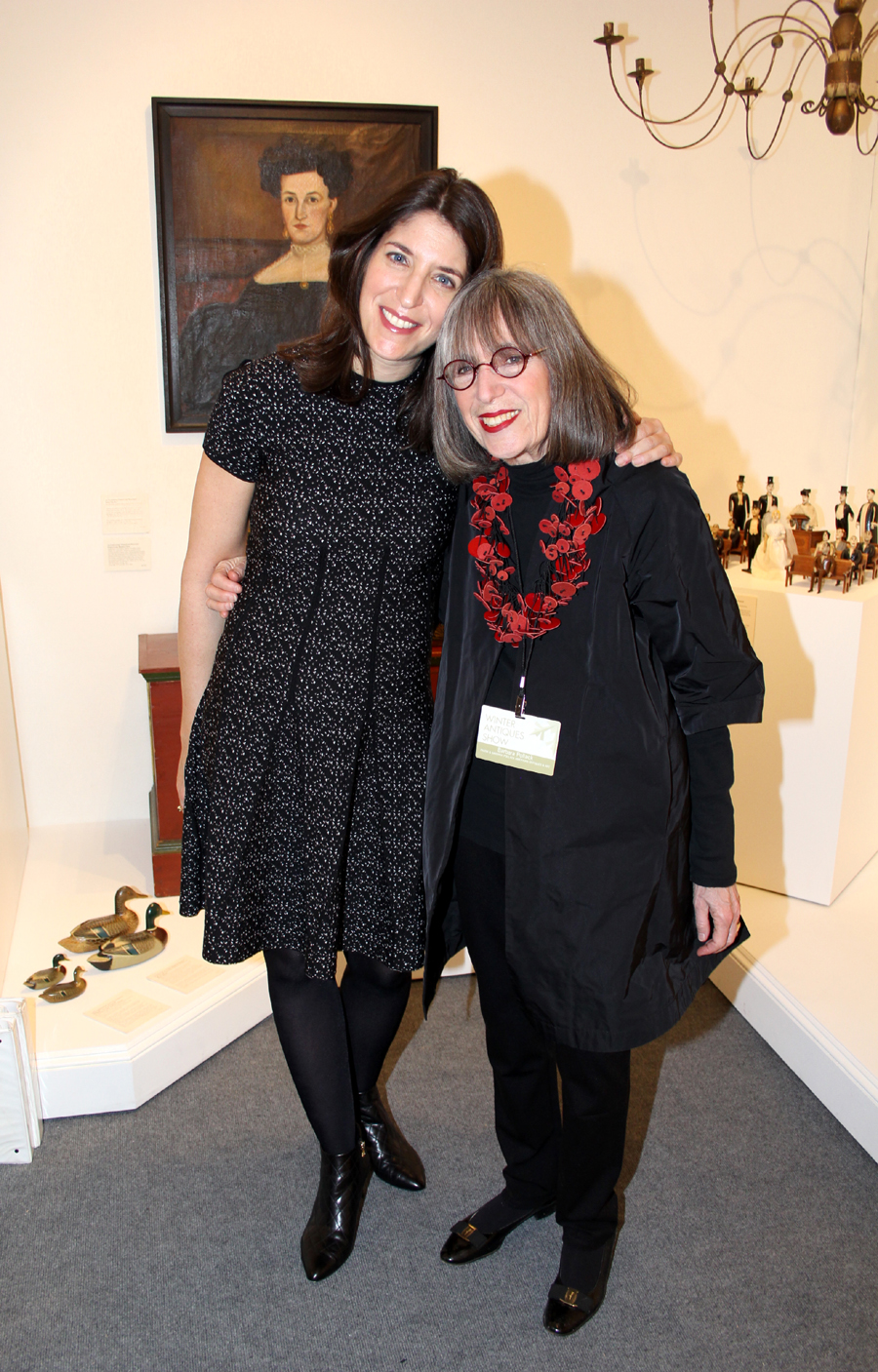
A senior vice president at Sotheby’s, Jodi Pollack cheered on her mother, exhibitor Barbara Pollack.
Benefiting East Side House Settlement, the 62nd Winter Antiques Show was more symphonic than ever this year, with each of its 73 specialist dealers contributing a distinct note to what overall was a bravura performance. In keeping with the times, the fair is pivoting to the international and contemporary, removing datelines and introducing works by living artists represented in major museum collections. It has done so without losing its distinctive character or sense of timeless traditionalism. A compendium display mounted by the Wadsworth Atheneum, whose genesis in 1842 grew from the efforts of the prototypical American collector Daniel Wadsworth, reflected the show’s broad stance and acquisitive impulses.
American art in all its manifestations remains the fair’s backbone. Peter Eaton, a specialist in early New England furniture, got off to a fine start. By the close of opening day, the Newbury, Mass., dealer sold a couple of very good smalls and 11 pieces of furniture, chief among them a paint decorated press cupboard, one of three known, made in or near Hampton, N.H., circa 1720–30. His partner, Joan Brownstein, sold a silk picture, several daguerreotypes and a circa 1785 portrait of a girl attributed to Abraham Delanoy Jr, a designation based on stylistic comparisons with known Delanoy portraits of the family of John Sherman of Connecticut.
At Nathan Liverant and Son, there was something enormously cheerful about a Federal cherry and figured maple desk and bookcase whose glazed upper doors presented a lively pattern of diamonds and figure eights. The Connecticut River Valley example of circa 1805–30 paired nicely with a compact cherry blockfront chest of drawers attributed to Samuel Loomis III (1748–1815) of Colchester, Conn., 1760–85, and an unsurpassed pair of Eliphalet Chapin side chairs. Liverant’s sales included a Rhode Island sideboard by Thomas Howard, a curly maple desk on frame, an oxbow bureau, a Chapin candlestand, paint decorated high chairs and a Rockwell Kent engraving.
New York dealer Frank Levy used the show to good purpose, making sales on the spot and culminating others at Levy Galleries, a cab ride way on East 84th Street. A Queen Anne tray-top tea table attributed to Newport, R.I., cabinetmaker John Goddard, circa 1760, was a centerpiece of his display.
Inlaid with an engraved silver medallion, a tea table used by General George Washington at his Newburgh, N.Y., headquarters during the Revolutionary War was a talking point at S.J. Shrubsole. The New York dealer was presenting a private collection of Twentieth Century silver back at its 57th Street shop.
“We sold quite a variety of silver and jewelry right across the board, including a Garrard turquoise and diamond bracelet of about 1860 in its original box, and a Queen Anne chocolate pot of 1707 by William Denny,” said Jim McConnaughy, senior vice president at Shrubsole.
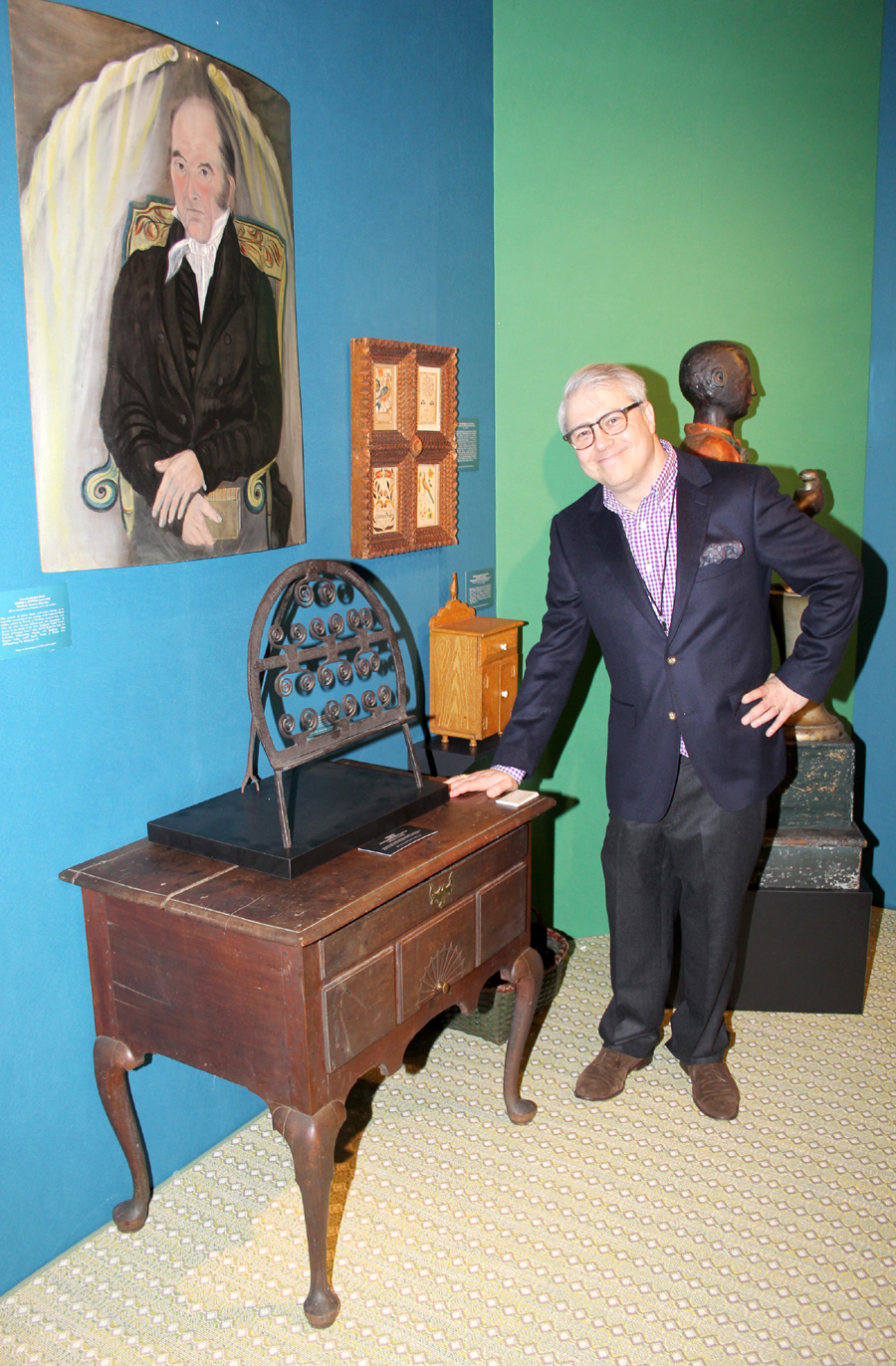
David Schorsch offered a new discovery, the circa 1775 cherry lowboy by Joseph Ferris of Newtown, Conn.
“I’m so happy to have three Boston worktables, two Federal examples by Thomas Seymour and possibly John Seymour, and the third, a Neoclassical example, by Rufus Pierce,” said Hirschl & Adler’s Liz Feld. The New York gallery sold the Sheraton-style table on opening night. Above it hung Gilbert Stuart’s “Portrait of George Washington” of about 1798.
A favorite with American curators and collectors, Martin Levy of H. Blairman and Sons, Ltd, London, delighted with a circa 1930 oak and ebony inlaid sideboard designed by Peter Waals; a cabinet designed by W.A.S. Benson for Morris & Co., circa 1900; and a circular book table designed by Joseph H. Johnson for Heal & Son, Ltd, circa 1925. Levy said he “loves the well-organized and very collegial Winter Antiques Show, along with its loyal and developing audience.” As for the snow, “The fair kept open and, although the footfall was inevitably smaller, those who came were there because they were seriously interested.”
London dealer Apter-Fredericks pitched fine Eighteenth Century English furniture against a simulated New York skyline, evoking contemporary penthouse living in the modern metropolis. Another London dealer, Ronald Phillips, opted for traditional luxe, showing a sumptuous George I green japanned bureau cabinet attributed to John Belchier, circa 1715, with Lafont glass chandeliers, patented 1798.
Robert Young’s winning brand of English vernacular art appeals to a broad swath of buyers. “We sold across the board: furniture, folk art objects and sculpture, pictures, treen and metalware. It was not a bumper or record year for us, but it was rewarding to find such genuine appetite for our vernacular pieces and to make consistent sales,” Young said.
In the American folk art category, David Schorsch and Eileen Smiles made early sales of a circa 1850 carved walnut figure of General George Washington, a decorated Pennsylvania redware bowl and a folk portrait of an American frigate, possibly the USS Franklin, in New York Harbor.
Illinois dealer Barbara Pollack was justly proud of her watercolor and pencil on paper drawing depicting Hannah Pearson Cogswell Badger (1791–1869) and her sister Julia instructing female students at the Atkinson Academy in Atkinson, N.H. The piece will be included in a major exhibition of schoolgirl art opening at the Fenimore Art Museum in Cooperstown, N.Y., on October 1.
There were new discoveries and old favorites. Schorsch & Smiles featured the Joseph Ferris circa 1775 Newtown, Conn., lowboy, a cherry and poplar example that remained in the family until recently. Likewise, the most exciting piece in Kelly Kinzle’s stand may have been a primitive, early Nineteenth Century wooden rooster weathervane that topped a Lancaster County, Penn., farm building for most of its life. Kinzle sold a copper fox weathervane attributed to Ohio maker W.H. Mullins, stoneware and a painted box. A portrait of George Washington went to a major museum.
“We’re so excited to get this,” Ed Hild said of a Nineteenth Century figural trade sign well known from the Edith Gregor Halpert collection. Against the backdrop of “The Lion,” an edgy, 1963 relief construction by Maine artist Bernard Langlais, Olde Hope Antiques wrote up a paint decorated chest, a trade sign inscribed “American House” and a whale weathervane.
A vibrant Suzani embroidery beckoned at Peter Pap Oriental Rugs. The dealer sold two very fine, unusually sized Serapis and noted interest in small rugs and runners. “I think this signals people using rugs in new ways, more as accent pieces as opposed to filling a room,” said Pap, who maintains showrooms in San Francisco and New Hampshire.
A large, beautifully worked silk memorial stitched by Sarah Kuhn of Boston in 1812 occupied center stage at needlework specialists Stephen and Carol Huber of Old Saybrook, Conn. Across the aisle, Gemini mounted the show’s first display of antique toys and banks, an indication of the growing stature of this collecting category.
Adding English and Continental pieces to their mostly American inventory has worked well for Massachusetts dealers Elliott and Grace Snyder. “We had an excellent show,” Grace acknowledged. “We sold four pieces of English embroidery right away, including a beadwork mirror, and had a very interesting strip sampler, which may turn out to be American. We sold five pieces of furniture, all American and mostly early, and the best piece of English slipware we’ve ever owned. During the second week, when more European buyers are in town, we sold early iron, mostly Spanish and Continental, and small items from our showcase.”
“We presented this year an extraordinary pair of late Seventeen Century tulip vases, which sold on opening night,” said Celine Ariaans, gallery manager at Aronson Antiquairs of Amsterdam.
Best of show in the American fine arts division included the Elie Nadelman wood sculpture “Standing Girl (Hostess)” and Andrew Wyeth’s “Ericksons,” a tempera on panel, at Michael Altman Fine Art.
“This is Henry Koerner’s masterpiece. I feel very lucky to be representing it,” Jonathan Boos said of “The Pigeons,” a dreamlike New York view with Brooklyn Borough Hall in the background.
Conner-Rosenkranz built its luminous presentation around a pair of Robert Winthrop Chanler stained glass windows commissioned in 1918 by Gertrude Vanderbilt Whitney for her Greenwich Village studio.
An exceptional Thomas Moran seascape of 1907 and the John Frederick Peto trompe l’oeil “Twenty Dollar Bill,” 1889, were highlights at Schwarz Gallery of Philadelphia.
Steadily diversifying her antiquarian line, Elle Shushan featured miniature portraits by Bettina von Zwehl, a German photographer living in London.
Known for Flemish paintings, new exhibitor De Jonckheere wowed with Pieter Bruegel the Younger’s “The Wedding Procession” of 1627.
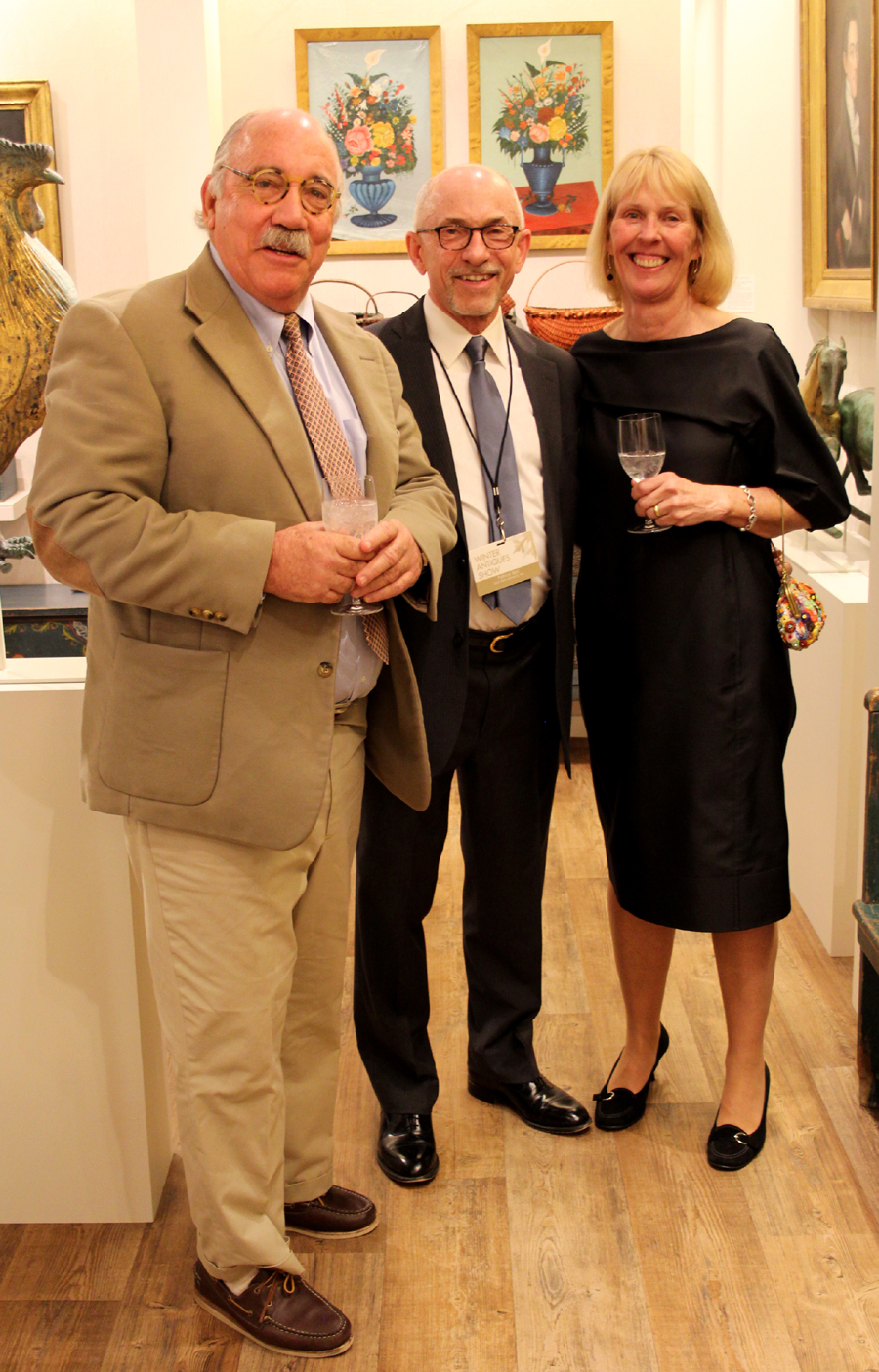
Ron and Debbie Pook checked in with exhibitor Pat Bell, center, at Olde Hope Antiques, New Hope, Penn.
Dubbed “the most important map in American history,” John Mitchell’s 1755 survey of the British and French Dominions in North America halted traffic at Arader Galleries.
New York’s Old Print Shop offered the comparably scarce “Plan of the City of New York” of 1803, compiled by Joseph-Francois Mangin and Casimir Goerck, and engraved by Peter Maverick.
Rupert Wace and Spencer Throckmorton divvy up the ancient world, Wace representing Greek, Roman and Egyptian pieces and Throckmorton focusing on Pre-Columbian work. “In the end, we sold a total of 21 pieces to both established clients as well as to three new collectors,” said gallery director Kraige Block.
Featuring postwar and contemporary American and European design, new exhibitor Paul Donzella said he had a great fair in the end. “We were welcomed by many and made to feel like a valuable addition to this prestigious show.”
A foremost authority on Japanese art and a longtime Winter Show exhibitor, Joan B. Mirviss was at last able to fully represent at the fair the modern and contemporary pottery that is today her chief focus. Only two pieces remain from her solo show by Kato Yasukage. Mirviss sold a total of 48 modern and contemporary vessels in all.
The weather was no match for Barbara Israel, whose garden oasis is a favorite attraction. The New York dealer parted with four pineapple finials, a Rip Van Winkle wall fountain, chimney pots, French terra cotta mounted figures, a pair of benches, a marble fountain and a pair of lions.
For additional information, www.winterantiquesshow.com or 718- 292-7392.
Gallery

